Developing Manager: A Comprehensive Guide to Management Skills and Career Development
VerifiedAdded on 2024/06/27
|25
|4788
|284
AI Summary
This report delves into the multifaceted role of a developing manager, exploring key management styles, leadership characteristics, and communication processes within the context of the airline industry. It further examines the importance of personal and managerial skills for career development, utilizing a SWOT analysis and a comprehensive career business plan. The report also highlights the significance of motivation and managerial decision-making in achieving organizational goals, using the example of a restaurant company.
Contribute Materials
Your contribution can guide someone’s learning journey. Share your
documents today.
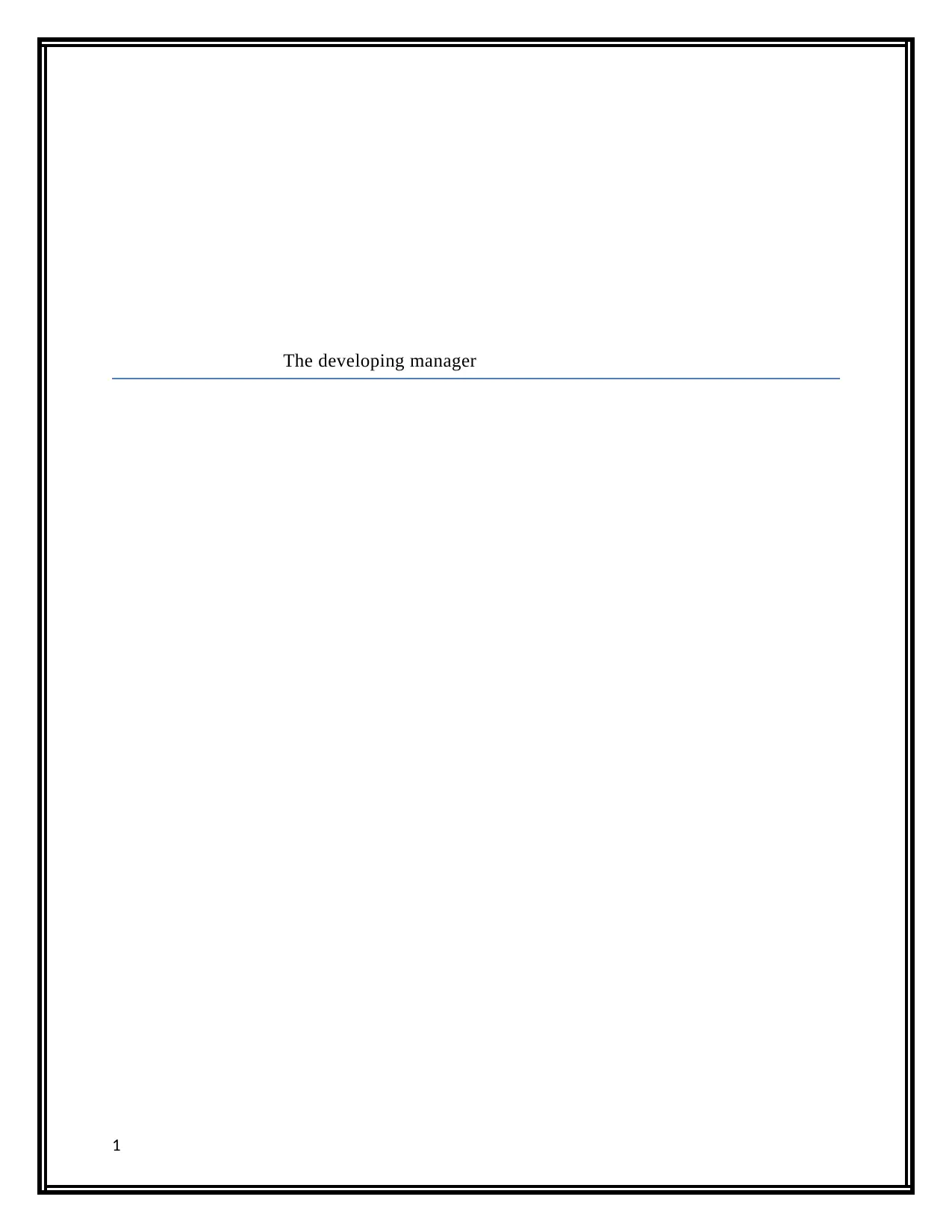
The developing manager
1
1
Secure Best Marks with AI Grader
Need help grading? Try our AI Grader for instant feedback on your assignments.
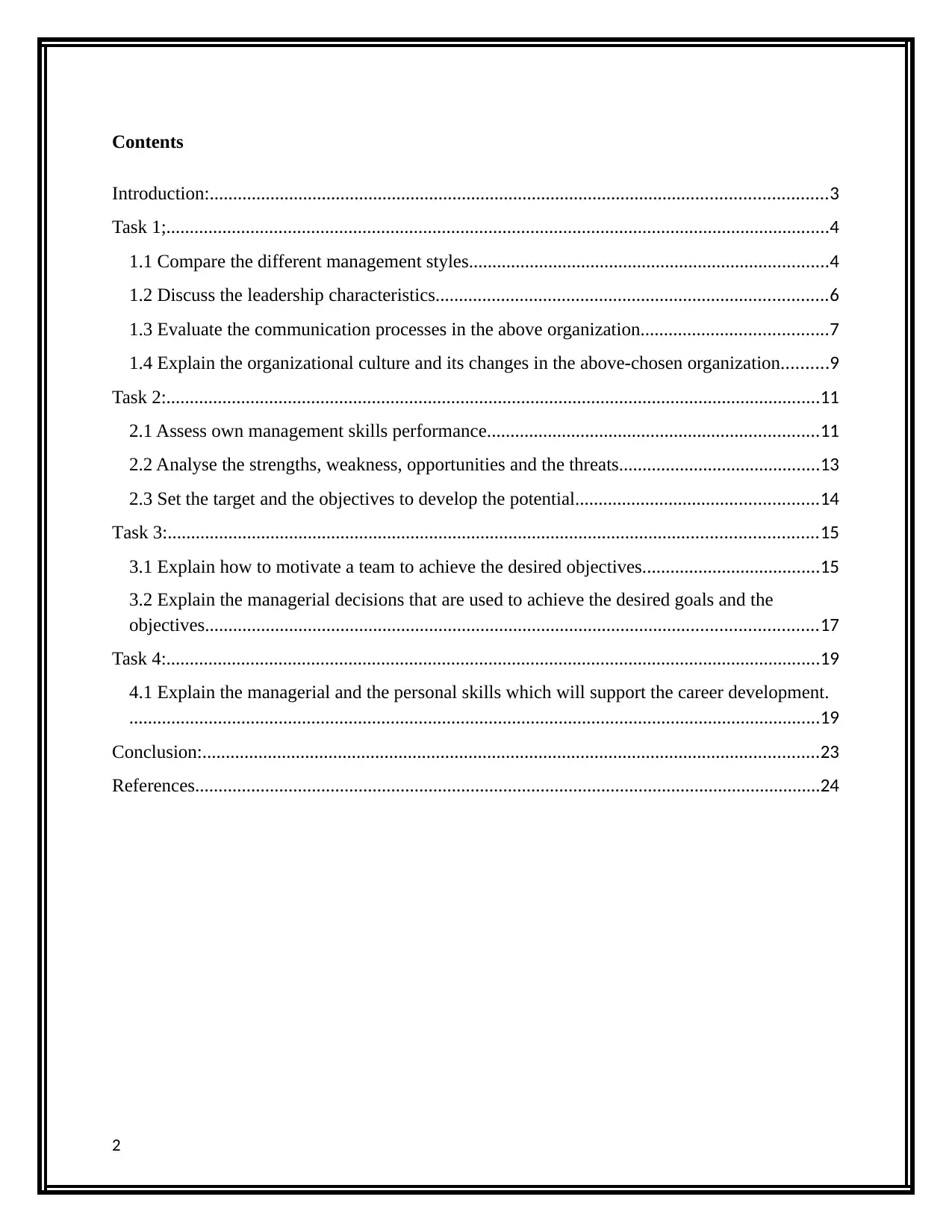
Contents
Introduction:....................................................................................................................................3
Task 1;..............................................................................................................................................4
1.1 Compare the different management styles.............................................................................4
1.2 Discuss the leadership characteristics....................................................................................6
1.3 Evaluate the communication processes in the above organization........................................7
1.4 Explain the organizational culture and its changes in the above-chosen organization..........9
Task 2:............................................................................................................................................11
2.1 Assess own management skills performance.......................................................................11
2.2 Analyse the strengths, weakness, opportunities and the threats...........................................13
2.3 Set the target and the objectives to develop the potential....................................................14
Task 3:...........................................................................................................................................15
3.1 Explain how to motivate a team to achieve the desired objectives......................................15
3.2 Explain the managerial decisions that are used to achieve the desired goals and the
objectives...................................................................................................................................17
Task 4:............................................................................................................................................19
4.1 Explain the managerial and the personal skills which will support the career development.
....................................................................................................................................................19
Conclusion:....................................................................................................................................23
References......................................................................................................................................24
2
Introduction:....................................................................................................................................3
Task 1;..............................................................................................................................................4
1.1 Compare the different management styles.............................................................................4
1.2 Discuss the leadership characteristics....................................................................................6
1.3 Evaluate the communication processes in the above organization........................................7
1.4 Explain the organizational culture and its changes in the above-chosen organization..........9
Task 2:............................................................................................................................................11
2.1 Assess own management skills performance.......................................................................11
2.2 Analyse the strengths, weakness, opportunities and the threats...........................................13
2.3 Set the target and the objectives to develop the potential....................................................14
Task 3:...........................................................................................................................................15
3.1 Explain how to motivate a team to achieve the desired objectives......................................15
3.2 Explain the managerial decisions that are used to achieve the desired goals and the
objectives...................................................................................................................................17
Task 4:............................................................................................................................................19
4.1 Explain the managerial and the personal skills which will support the career development.
....................................................................................................................................................19
Conclusion:....................................................................................................................................23
References......................................................................................................................................24
2
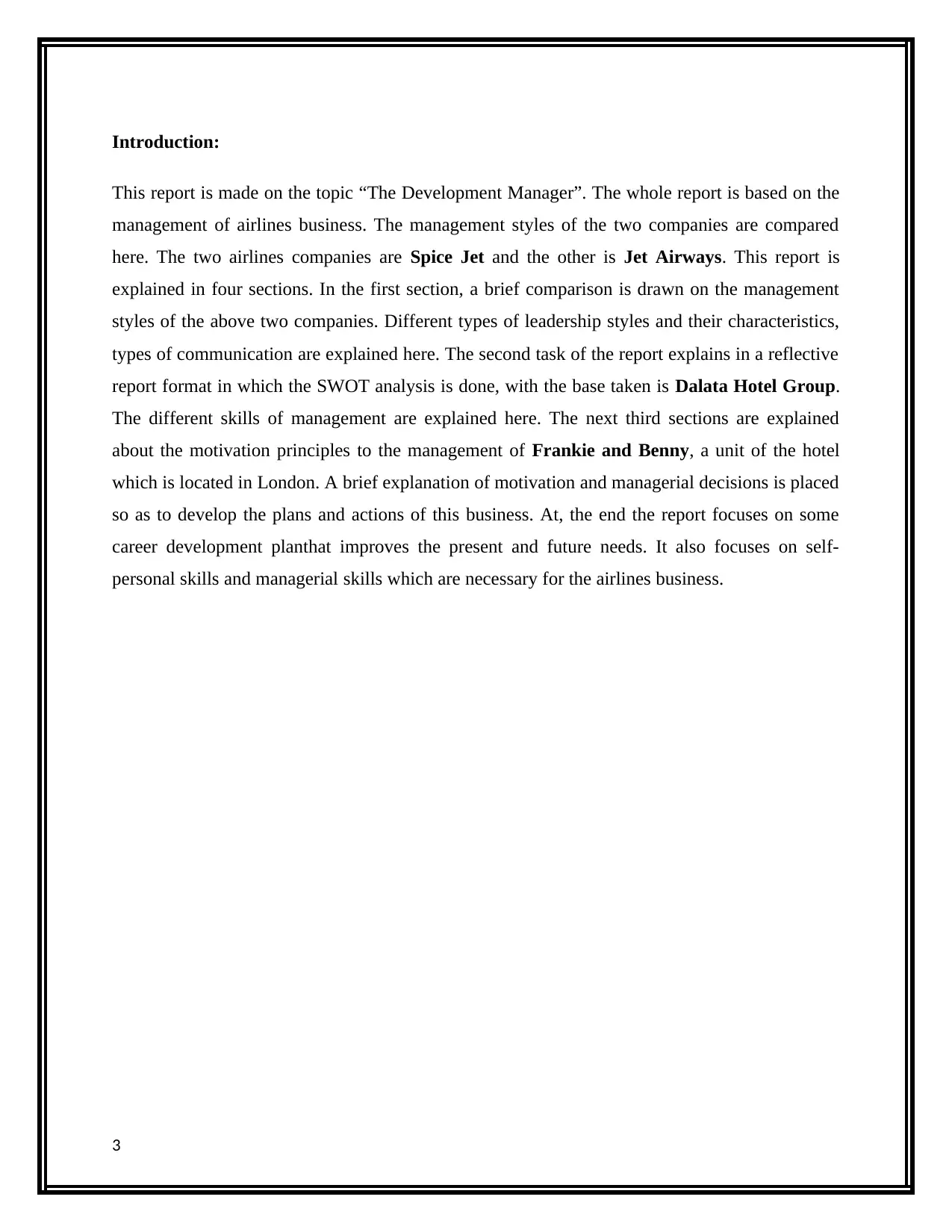
Introduction:
This report is made on the topic “The Development Manager”. The whole report is based on the
management of airlines business. The management styles of the two companies are compared
here. The two airlines companies are Spice Jet and the other is Jet Airways. This report is
explained in four sections. In the first section, a brief comparison is drawn on the management
styles of the above two companies. Different types of leadership styles and their characteristics,
types of communication are explained here. The second task of the report explains in a reflective
report format in which the SWOT analysis is done, with the base taken is Dalata Hotel Group.
The different skills of management are explained here. The next third sections are explained
about the motivation principles to the management of Frankie and Benny, a unit of the hotel
which is located in London. A brief explanation of motivation and managerial decisions is placed
so as to develop the plans and actions of this business. At, the end the report focuses on some
career development planthat improves the present and future needs. It also focuses on self-
personal skills and managerial skills which are necessary for the airlines business.
3
This report is made on the topic “The Development Manager”. The whole report is based on the
management of airlines business. The management styles of the two companies are compared
here. The two airlines companies are Spice Jet and the other is Jet Airways. This report is
explained in four sections. In the first section, a brief comparison is drawn on the management
styles of the above two companies. Different types of leadership styles and their characteristics,
types of communication are explained here. The second task of the report explains in a reflective
report format in which the SWOT analysis is done, with the base taken is Dalata Hotel Group.
The different skills of management are explained here. The next third sections are explained
about the motivation principles to the management of Frankie and Benny, a unit of the hotel
which is located in London. A brief explanation of motivation and managerial decisions is placed
so as to develop the plans and actions of this business. At, the end the report focuses on some
career development planthat improves the present and future needs. It also focuses on self-
personal skills and managerial skills which are necessary for the airlines business.
3
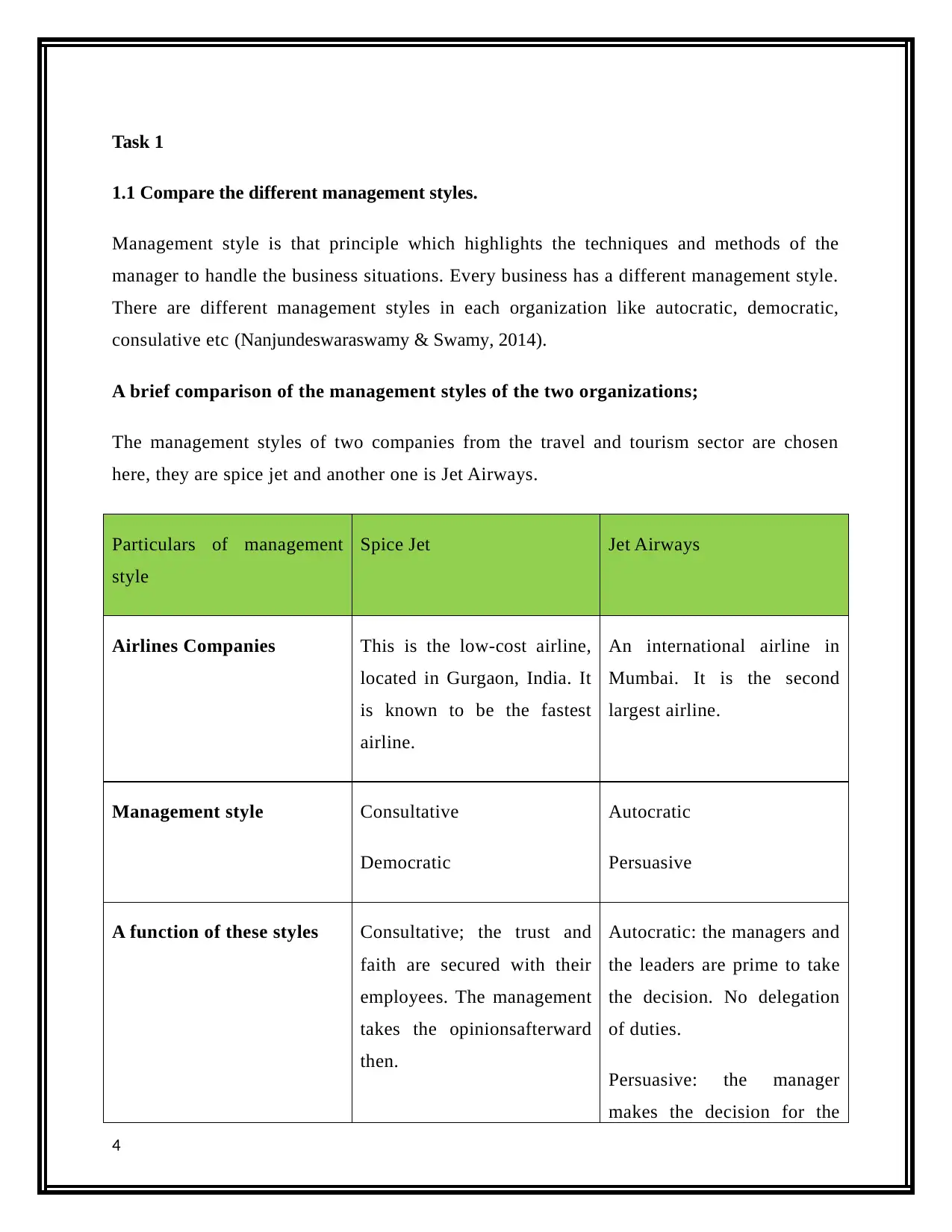
Task 1
1.1 Compare the different management styles.
Management style is that principle which highlights the techniques and methods of the
manager to handle the business situations. Every business has a different management style.
There are different management styles in each organization like autocratic, democratic,
consulative etc (Nanjundeswaraswamy & Swamy, 2014).
A brief comparison of the management styles of the two organizations;
The management styles of two companies from the travel and tourism sector are chosen
here, they are spice jet and another one is Jet Airways.
Particulars of management
style
Spice Jet Jet Airways
Airlines Companies This is the low-cost airline,
located in Gurgaon, India. It
is known to be the fastest
airline.
An international airline in
Mumbai. It is the second
largest airline.
Management style Consultative
Democratic
Autocratic
Persuasive
A function of these styles Consultative; the trust and
faith are secured with their
employees. The management
takes the opinionsafterward
then.
Autocratic: the managers and
the leaders are prime to take
the decision. No delegation
of duties.
Persuasive: the manager
makes the decision for the
4
1.1 Compare the different management styles.
Management style is that principle which highlights the techniques and methods of the
manager to handle the business situations. Every business has a different management style.
There are different management styles in each organization like autocratic, democratic,
consulative etc (Nanjundeswaraswamy & Swamy, 2014).
A brief comparison of the management styles of the two organizations;
The management styles of two companies from the travel and tourism sector are chosen
here, they are spice jet and another one is Jet Airways.
Particulars of management
style
Spice Jet Jet Airways
Airlines Companies This is the low-cost airline,
located in Gurgaon, India. It
is known to be the fastest
airline.
An international airline in
Mumbai. It is the second
largest airline.
Management style Consultative
Democratic
Autocratic
Persuasive
A function of these styles Consultative; the trust and
faith are secured with their
employees. The management
takes the opinionsafterward
then.
Autocratic: the managers and
the leaders are prime to take
the decision. No delegation
of duties.
Persuasive: the manager
makes the decision for the
4
Secure Best Marks with AI Grader
Need help grading? Try our AI Grader for instant feedback on your assignments.
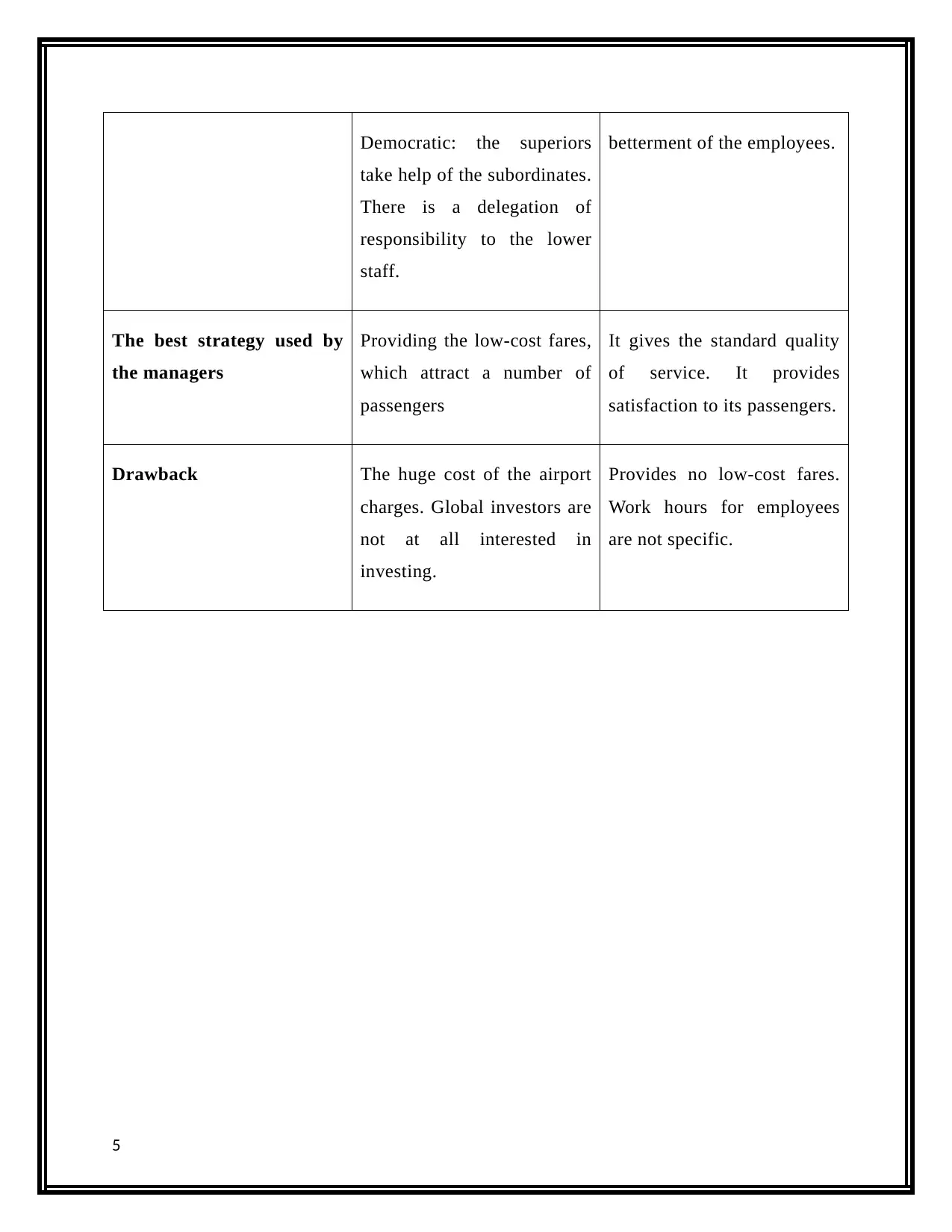
Democratic: the superiors
take help of the subordinates.
There is a delegation of
responsibility to the lower
staff.
betterment of the employees.
The best strategy used by
the managers
Providing the low-cost fares,
which attract a number of
passengers
It gives the standard quality
of service. It provides
satisfaction to its passengers.
Drawback The huge cost of the airport
charges. Global investors are
not at all interested in
investing.
Provides no low-cost fares.
Work hours for employees
are not specific.
5
take help of the subordinates.
There is a delegation of
responsibility to the lower
staff.
betterment of the employees.
The best strategy used by
the managers
Providing the low-cost fares,
which attract a number of
passengers
It gives the standard quality
of service. It provides
satisfaction to its passengers.
Drawback The huge cost of the airport
charges. Global investors are
not at all interested in
investing.
Provides no low-cost fares.
Work hours for employees
are not specific.
5
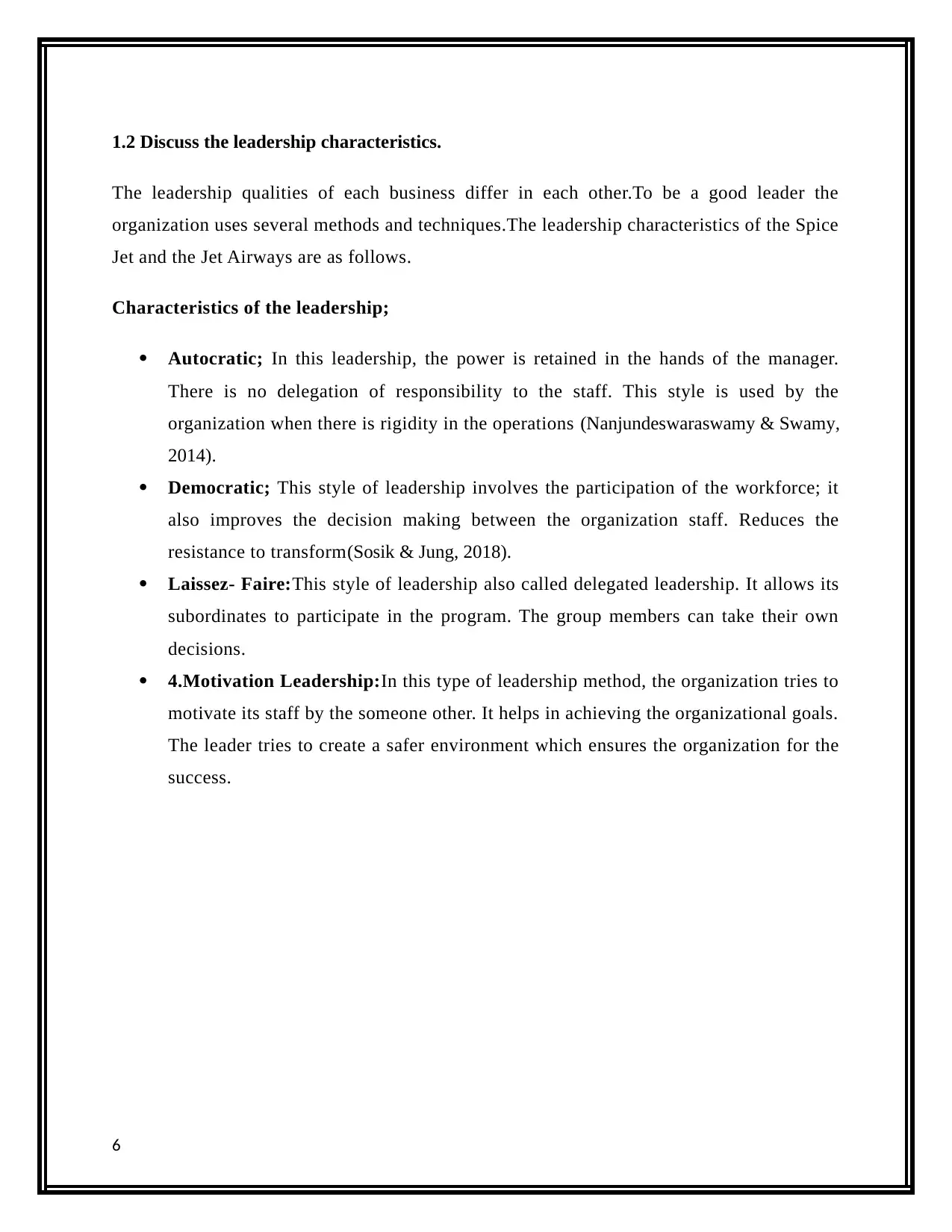
1.2 Discuss the leadership characteristics.
The leadership qualities of each business differ in each other.To be a good leader the
organization uses several methods and techniques.The leadership characteristics of the Spice
Jet and the Jet Airways are as follows.
Characteristics of the leadership;
Autocratic; In this leadership, the power is retained in the hands of the manager.
There is no delegation of responsibility to the staff. This style is used by the
organization when there is rigidity in the operations (Nanjundeswaraswamy & Swamy,
2014).
Democratic; This style of leadership involves the participation of the workforce; it
also improves the decision making between the organization staff. Reduces the
resistance to transform(Sosik & Jung, 2018).
Laissez- Faire:This style of leadership also called delegated leadership. It allows its
subordinates to participate in the program. The group members can take their own
decisions.
4.Motivation Leadership:In this type of leadership method, the organization tries to
motivate its staff by the someone other. It helps in achieving the organizational goals.
The leader tries to create a safer environment which ensures the organization for the
success.
6
The leadership qualities of each business differ in each other.To be a good leader the
organization uses several methods and techniques.The leadership characteristics of the Spice
Jet and the Jet Airways are as follows.
Characteristics of the leadership;
Autocratic; In this leadership, the power is retained in the hands of the manager.
There is no delegation of responsibility to the staff. This style is used by the
organization when there is rigidity in the operations (Nanjundeswaraswamy & Swamy,
2014).
Democratic; This style of leadership involves the participation of the workforce; it
also improves the decision making between the organization staff. Reduces the
resistance to transform(Sosik & Jung, 2018).
Laissez- Faire:This style of leadership also called delegated leadership. It allows its
subordinates to participate in the program. The group members can take their own
decisions.
4.Motivation Leadership:In this type of leadership method, the organization tries to
motivate its staff by the someone other. It helps in achieving the organizational goals.
The leader tries to create a safer environment which ensures the organization for the
success.
6
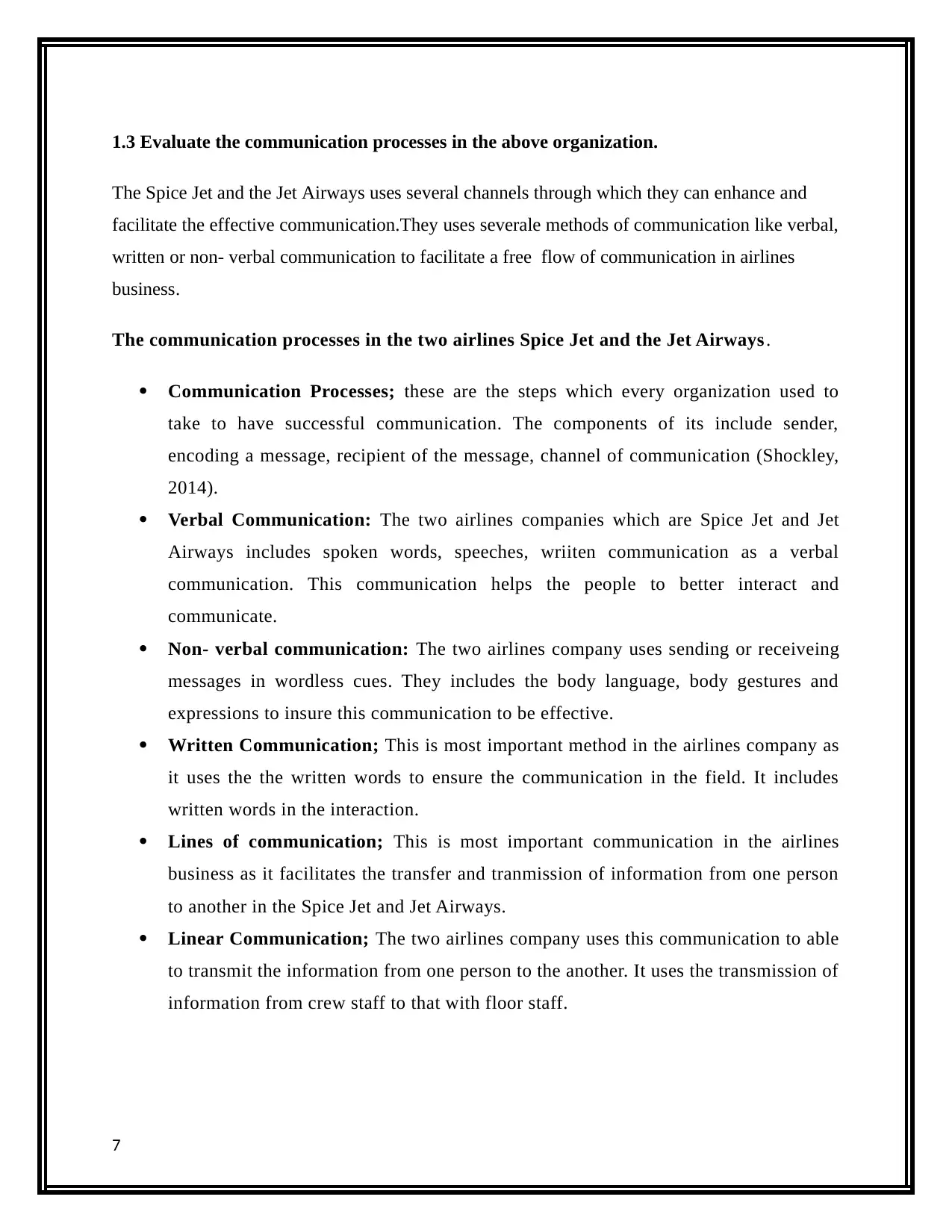
1.3 Evaluate the communication processes in the above organization.
The Spice Jet and the Jet Airways uses several channels through which they can enhance and
facilitate the effective communication.They uses severale methods of communication like verbal,
written or non- verbal communication to facilitate a free flow of communication in airlines
business.
The communication processes in the two airlines Spice Jet and the Jet Airways.
Communication Processes; these are the steps which every organization used to
take to have successful communication. The components of its include sender,
encoding a message, recipient of the message, channel of communication (Shockley,
2014).
Verbal Communication: The two airlines companies which are Spice Jet and Jet
Airways includes spoken words, speeches, wriiten communication as a verbal
communication. This communication helps the people to better interact and
communicate.
Non- verbal communication: The two airlines company uses sending or receiveing
messages in wordless cues. They includes the body language, body gestures and
expressions to insure this communication to be effective.
Written Communication; This is most important method in the airlines company as
it uses the the written words to ensure the communication in the field. It includes
written words in the interaction.
Lines of communication; This is most important communication in the airlines
business as it facilitates the transfer and tranmission of information from one person
to another in the Spice Jet and Jet Airways.
Linear Communication; The two airlines company uses this communication to able
to transmit the information from one person to the another. It uses the transmission of
information from crew staff to that with floor staff.
7
The Spice Jet and the Jet Airways uses several channels through which they can enhance and
facilitate the effective communication.They uses severale methods of communication like verbal,
written or non- verbal communication to facilitate a free flow of communication in airlines
business.
The communication processes in the two airlines Spice Jet and the Jet Airways.
Communication Processes; these are the steps which every organization used to
take to have successful communication. The components of its include sender,
encoding a message, recipient of the message, channel of communication (Shockley,
2014).
Verbal Communication: The two airlines companies which are Spice Jet and Jet
Airways includes spoken words, speeches, wriiten communication as a verbal
communication. This communication helps the people to better interact and
communicate.
Non- verbal communication: The two airlines company uses sending or receiveing
messages in wordless cues. They includes the body language, body gestures and
expressions to insure this communication to be effective.
Written Communication; This is most important method in the airlines company as
it uses the the written words to ensure the communication in the field. It includes
written words in the interaction.
Lines of communication; This is most important communication in the airlines
business as it facilitates the transfer and tranmission of information from one person
to another in the Spice Jet and Jet Airways.
Linear Communication; The two airlines company uses this communication to able
to transmit the information from one person to the another. It uses the transmission of
information from crew staff to that with floor staff.
7
Paraphrase This Document
Need a fresh take? Get an instant paraphrase of this document with our AI Paraphraser
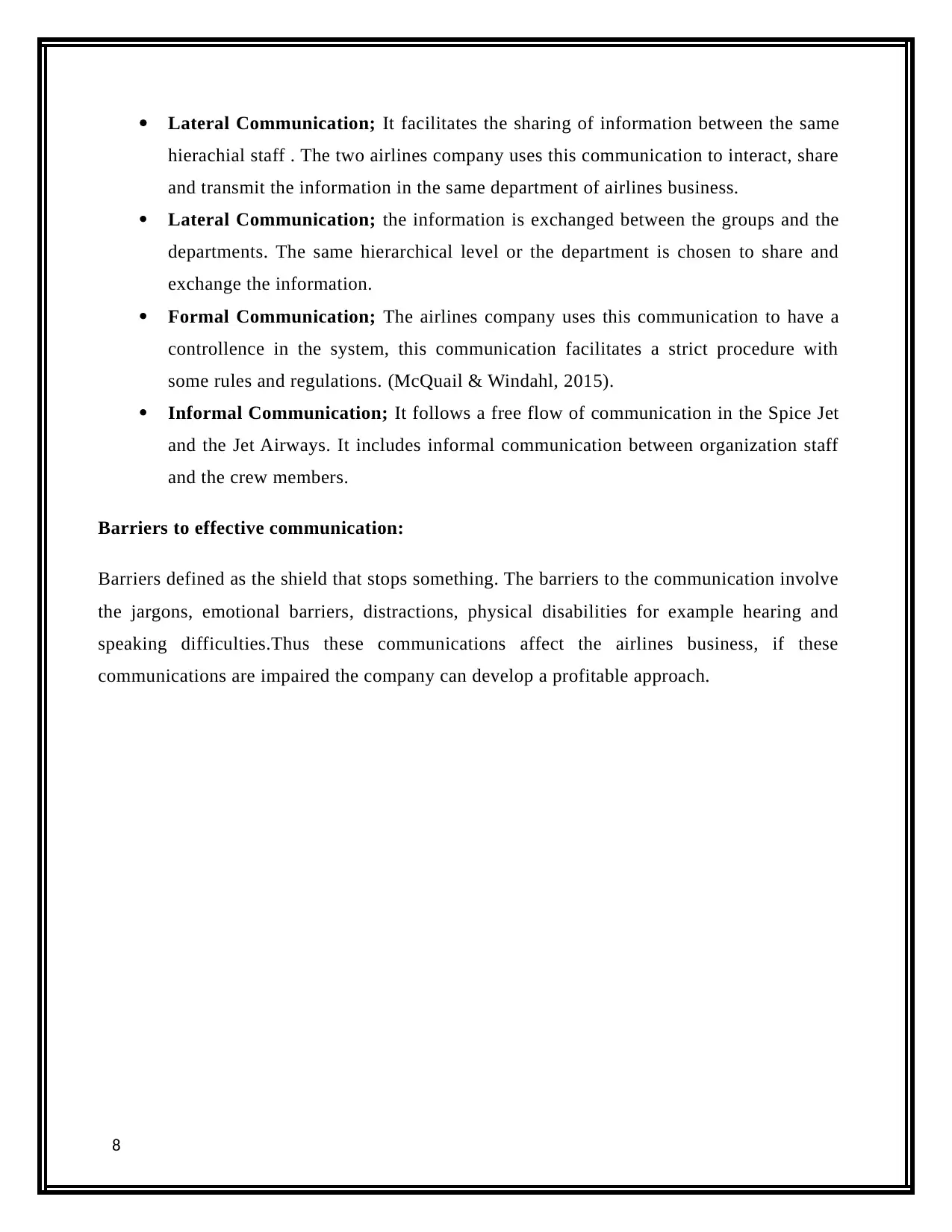
Lateral Communication; It facilitates the sharing of information between the same
hierachial staff . The two airlines company uses this communication to interact, share
and transmit the information in the same department of airlines business.
Lateral Communication; the information is exchanged between the groups and the
departments. The same hierarchical level or the department is chosen to share and
exchange the information.
Formal Communication; The airlines company uses this communication to have a
controllence in the system, this communication facilitates a strict procedure with
some rules and regulations. (McQuail & Windahl, 2015).
Informal Communication; It follows a free flow of communication in the Spice Jet
and the Jet Airways. It includes informal communication between organization staff
and the crew members.
Barriers to effective communication:
Barriers defined as the shield that stops something. The barriers to the communication involve
the jargons, emotional barriers, distractions, physical disabilities for example hearing and
speaking difficulties.Thus these communications affect the airlines business, if these
communications are impaired the company can develop a profitable approach.
8
hierachial staff . The two airlines company uses this communication to interact, share
and transmit the information in the same department of airlines business.
Lateral Communication; the information is exchanged between the groups and the
departments. The same hierarchical level or the department is chosen to share and
exchange the information.
Formal Communication; The airlines company uses this communication to have a
controllence in the system, this communication facilitates a strict procedure with
some rules and regulations. (McQuail & Windahl, 2015).
Informal Communication; It follows a free flow of communication in the Spice Jet
and the Jet Airways. It includes informal communication between organization staff
and the crew members.
Barriers to effective communication:
Barriers defined as the shield that stops something. The barriers to the communication involve
the jargons, emotional barriers, distractions, physical disabilities for example hearing and
speaking difficulties.Thus these communications affect the airlines business, if these
communications are impaired the company can develop a profitable approach.
8
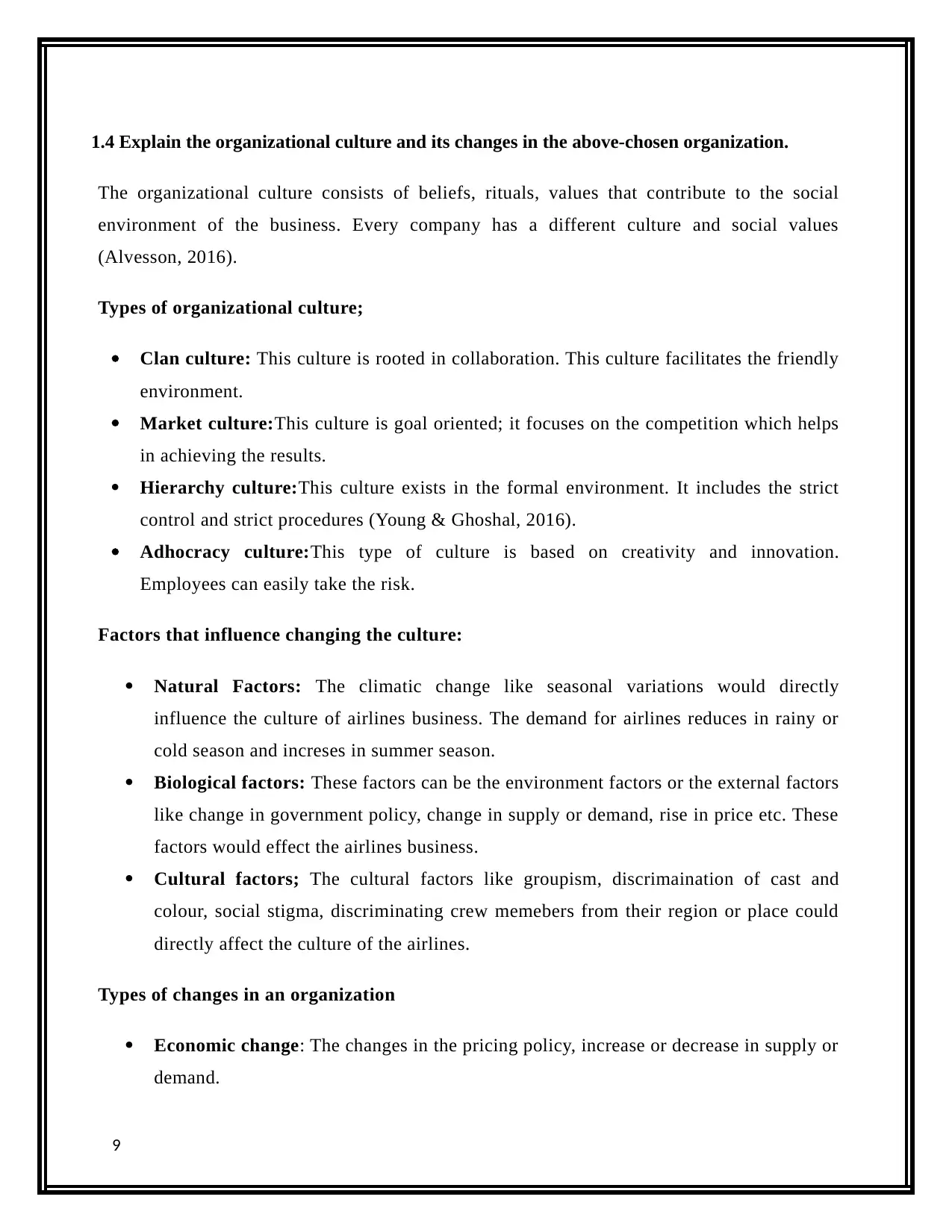
1.4 Explain the organizational culture and its changes in the above-chosen organization.
The organizational culture consists of beliefs, rituals, values that contribute to the social
environment of the business. Every company has a different culture and social values
(Alvesson, 2016).
Types of organizational culture;
Clan culture: This culture is rooted in collaboration. This culture facilitates the friendly
environment.
Market culture:This culture is goal oriented; it focuses on the competition which helps
in achieving the results.
Hierarchy culture:This culture exists in the formal environment. It includes the strict
control and strict procedures (Young & Ghoshal, 2016).
Adhocracy culture:This type of culture is based on creativity and innovation.
Employees can easily take the risk.
Factors that influence changing the culture:
Natural Factors: The climatic change like seasonal variations would directly
influence the culture of airlines business. The demand for airlines reduces in rainy or
cold season and increses in summer season.
Biological factors: These factors can be the environment factors or the external factors
like change in government policy, change in supply or demand, rise in price etc. These
factors would effect the airlines business.
Cultural factors; The cultural factors like groupism, discrimaination of cast and
colour, social stigma, discriminating crew memebers from their region or place could
directly affect the culture of the airlines.
Types of changes in an organization
Economic change: The changes in the pricing policy, increase or decrease in supply or
demand.
9
The organizational culture consists of beliefs, rituals, values that contribute to the social
environment of the business. Every company has a different culture and social values
(Alvesson, 2016).
Types of organizational culture;
Clan culture: This culture is rooted in collaboration. This culture facilitates the friendly
environment.
Market culture:This culture is goal oriented; it focuses on the competition which helps
in achieving the results.
Hierarchy culture:This culture exists in the formal environment. It includes the strict
control and strict procedures (Young & Ghoshal, 2016).
Adhocracy culture:This type of culture is based on creativity and innovation.
Employees can easily take the risk.
Factors that influence changing the culture:
Natural Factors: The climatic change like seasonal variations would directly
influence the culture of airlines business. The demand for airlines reduces in rainy or
cold season and increses in summer season.
Biological factors: These factors can be the environment factors or the external factors
like change in government policy, change in supply or demand, rise in price etc. These
factors would effect the airlines business.
Cultural factors; The cultural factors like groupism, discrimaination of cast and
colour, social stigma, discriminating crew memebers from their region or place could
directly affect the culture of the airlines.
Types of changes in an organization
Economic change: The changes in the pricing policy, increase or decrease in supply or
demand.
9
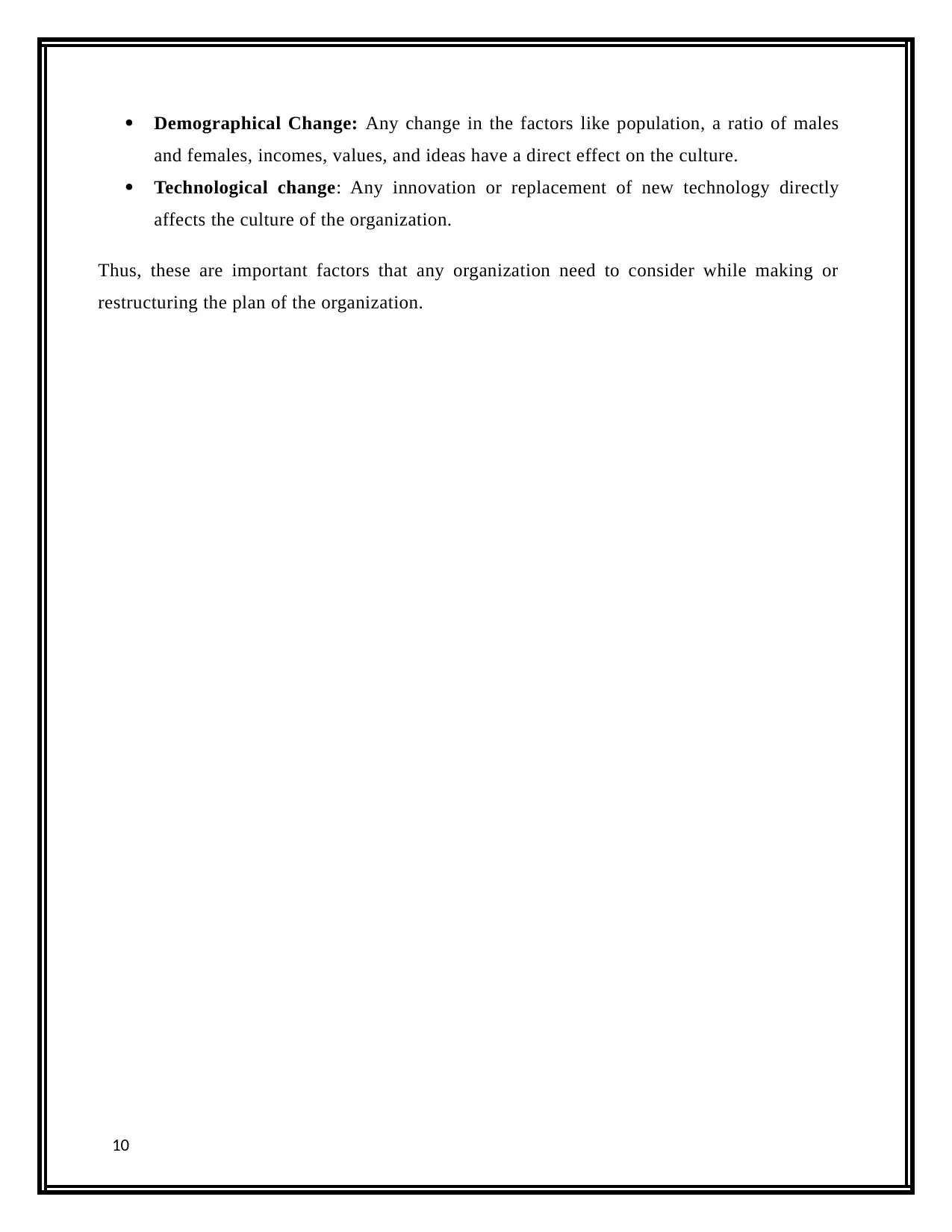
Demographical Change: Any change in the factors like population, a ratio of males
and females, incomes, values, and ideas have a direct effect on the culture.
Technological change: Any innovation or replacement of new technology directly
affects the culture of the organization.
Thus, these are important factors that any organization need to consider while making or
restructuring the plan of the organization.
10
and females, incomes, values, and ideas have a direct effect on the culture.
Technological change: Any innovation or replacement of new technology directly
affects the culture of the organization.
Thus, these are important factors that any organization need to consider while making or
restructuring the plan of the organization.
10
Secure Best Marks with AI Grader
Need help grading? Try our AI Grader for instant feedback on your assignments.
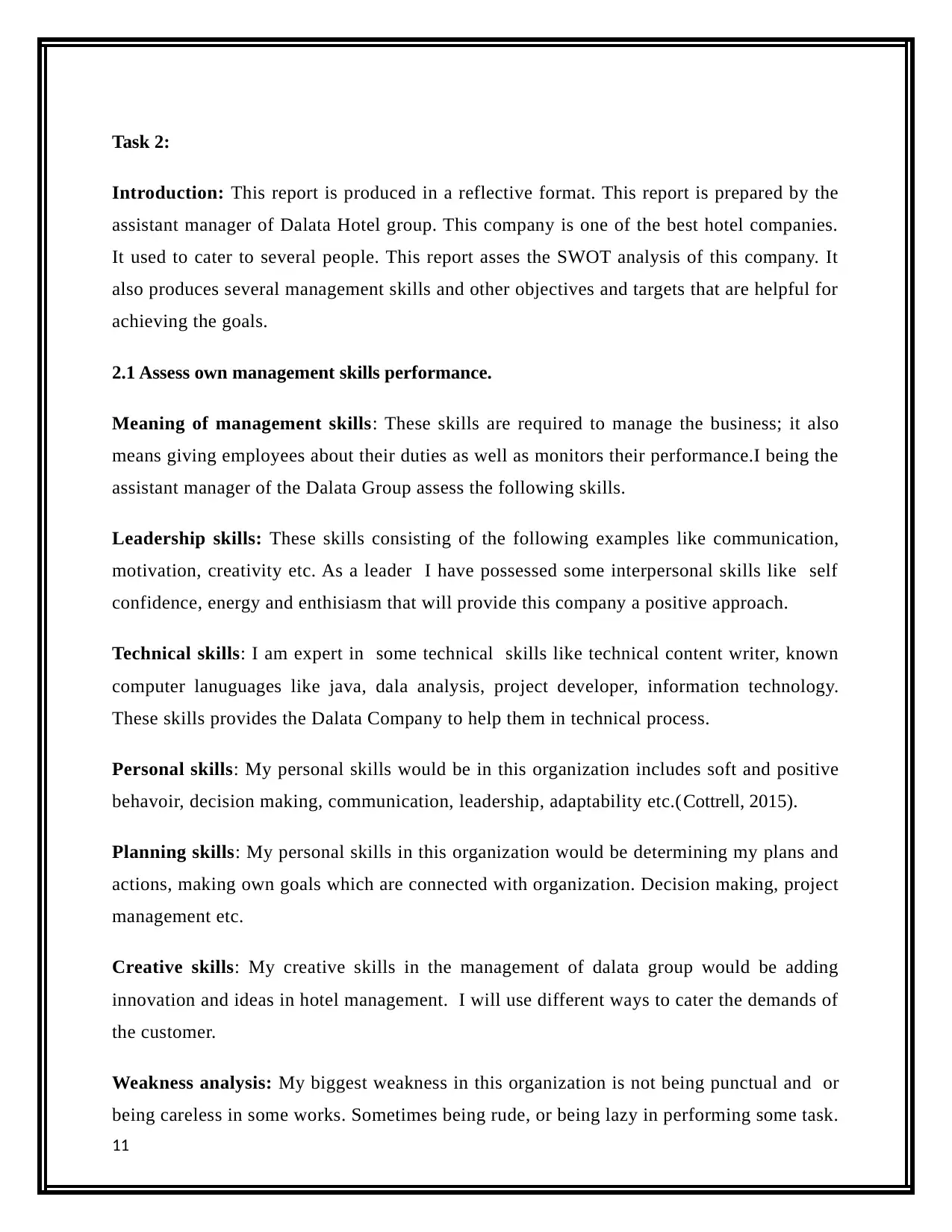
Task 2:
Introduction: This report is produced in a reflective format. This report is prepared by the
assistant manager of Dalata Hotel group. This company is one of the best hotel companies.
It used to cater to several people. This report asses the SWOT analysis of this company. It
also produces several management skills and other objectives and targets that are helpful for
achieving the goals.
2.1 Assess own management skills performance.
Meaning of management skills: These skills are required to manage the business; it also
means giving employees about their duties as well as monitors their performance.I being the
assistant manager of the Dalata Group assess the following skills.
Leadership skills: These skills consisting of the following examples like communication,
motivation, creativity etc. As a leader I have possessed some interpersonal skills like self
confidence, energy and enthisiasm that will provide this company a positive approach.
Technical skills: I am expert in some technical skills like technical content writer, known
computer lanuguages like java, dala analysis, project developer, information technology.
These skills provides the Dalata Company to help them in technical process.
Personal skills: My personal skills would be in this organization includes soft and positive
behavoir, decision making, communication, leadership, adaptability etc.(Cottrell, 2015).
Planning skills: My personal skills in this organization would be determining my plans and
actions, making own goals which are connected with organization. Decision making, project
management etc.
Creative skills: My creative skills in the management of dalata group would be adding
innovation and ideas in hotel management. I will use different ways to cater the demands of
the customer.
Weakness analysis: My biggest weakness in this organization is not being punctual and or
being careless in some works. Sometimes being rude, or being lazy in performing some task.
11
Introduction: This report is produced in a reflective format. This report is prepared by the
assistant manager of Dalata Hotel group. This company is one of the best hotel companies.
It used to cater to several people. This report asses the SWOT analysis of this company. It
also produces several management skills and other objectives and targets that are helpful for
achieving the goals.
2.1 Assess own management skills performance.
Meaning of management skills: These skills are required to manage the business; it also
means giving employees about their duties as well as monitors their performance.I being the
assistant manager of the Dalata Group assess the following skills.
Leadership skills: These skills consisting of the following examples like communication,
motivation, creativity etc. As a leader I have possessed some interpersonal skills like self
confidence, energy and enthisiasm that will provide this company a positive approach.
Technical skills: I am expert in some technical skills like technical content writer, known
computer lanuguages like java, dala analysis, project developer, information technology.
These skills provides the Dalata Company to help them in technical process.
Personal skills: My personal skills would be in this organization includes soft and positive
behavoir, decision making, communication, leadership, adaptability etc.(Cottrell, 2015).
Planning skills: My personal skills in this organization would be determining my plans and
actions, making own goals which are connected with organization. Decision making, project
management etc.
Creative skills: My creative skills in the management of dalata group would be adding
innovation and ideas in hotel management. I will use different ways to cater the demands of
the customer.
Weakness analysis: My biggest weakness in this organization is not being punctual and or
being careless in some works. Sometimes being rude, or being lazy in performing some task.
11

Strength analysis: My biggest strength in this company would be acting smart, benevolent,
active nad compassionate towards the organizationb staff. My biggest strength would be to
ensure my goals should meet with the companies requirement
12
active nad compassionate towards the organizationb staff. My biggest strength would be to
ensure my goals should meet with the companies requirement
12
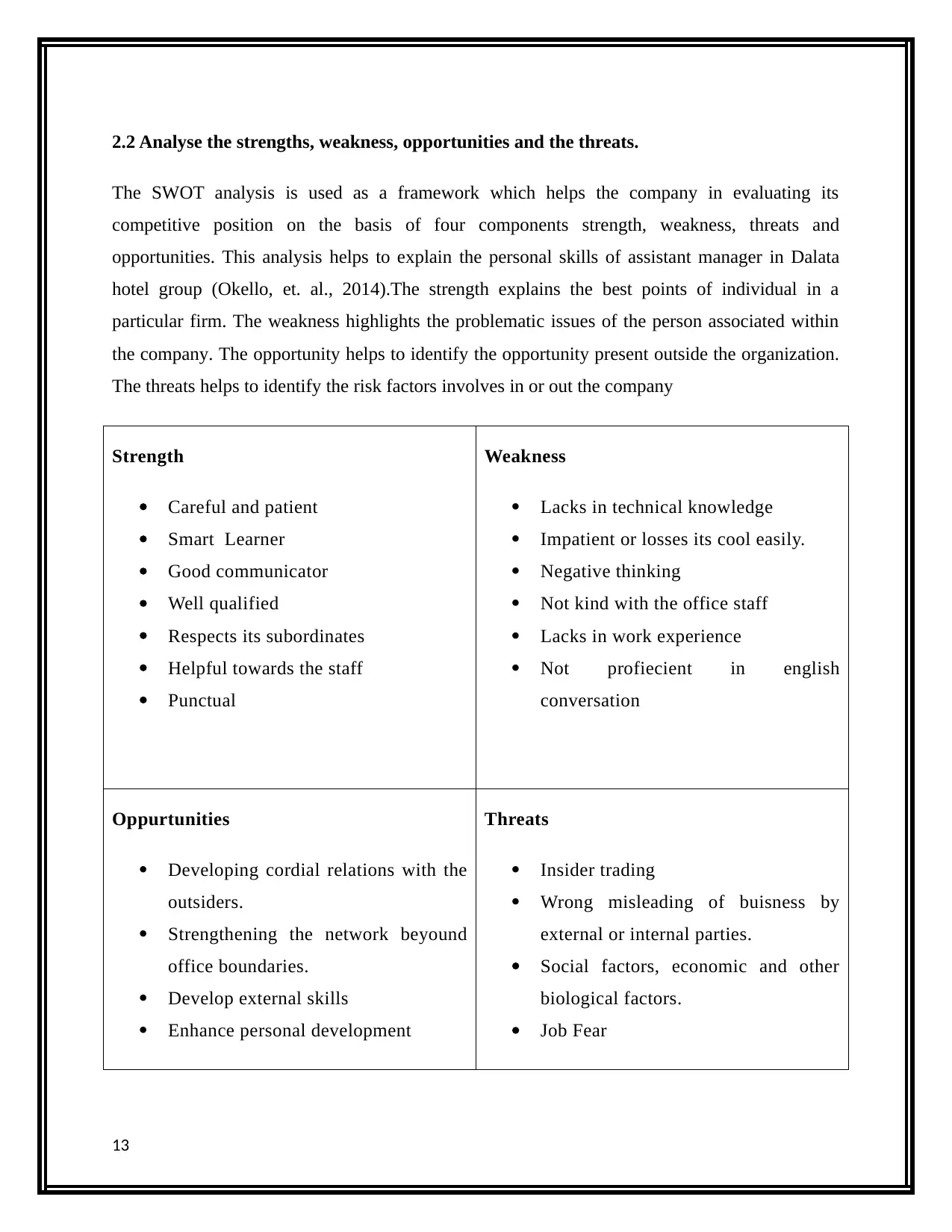
2.2 Analyse the strengths, weakness, opportunities and the threats.
The SWOT analysis is used as a framework which helps the company in evaluating its
competitive position on the basis of four components strength, weakness, threats and
opportunities. This analysis helps to explain the personal skills of assistant manager in Dalata
hotel group (Okello, et. al., 2014).The strength explains the best points of individual in a
particular firm. The weakness highlights the problematic issues of the person associated within
the company. The opportunity helps to identify the opportunity present outside the organization.
The threats helps to identify the risk factors involves in or out the company
Strength
Careful and patient
Smart Learner
Good communicator
Well qualified
Respects its subordinates
Helpful towards the staff
Punctual
Weakness
Lacks in technical knowledge
Impatient or losses its cool easily.
Negative thinking
Not kind with the office staff
Lacks in work experience
Not profiecient in english
conversation
Oppurtunities
Developing cordial relations with the
outsiders.
Strengthening the network beyound
office boundaries.
Develop external skills
Enhance personal development
Threats
Insider trading
Wrong misleading of buisness by
external or internal parties.
Social factors, economic and other
biological factors.
Job Fear
13
The SWOT analysis is used as a framework which helps the company in evaluating its
competitive position on the basis of four components strength, weakness, threats and
opportunities. This analysis helps to explain the personal skills of assistant manager in Dalata
hotel group (Okello, et. al., 2014).The strength explains the best points of individual in a
particular firm. The weakness highlights the problematic issues of the person associated within
the company. The opportunity helps to identify the opportunity present outside the organization.
The threats helps to identify the risk factors involves in or out the company
Strength
Careful and patient
Smart Learner
Good communicator
Well qualified
Respects its subordinates
Helpful towards the staff
Punctual
Weakness
Lacks in technical knowledge
Impatient or losses its cool easily.
Negative thinking
Not kind with the office staff
Lacks in work experience
Not profiecient in english
conversation
Oppurtunities
Developing cordial relations with the
outsiders.
Strengthening the network beyound
office boundaries.
Develop external skills
Enhance personal development
Threats
Insider trading
Wrong misleading of buisness by
external or internal parties.
Social factors, economic and other
biological factors.
Job Fear
13
Paraphrase This Document
Need a fresh take? Get an instant paraphrase of this document with our AI Paraphraser
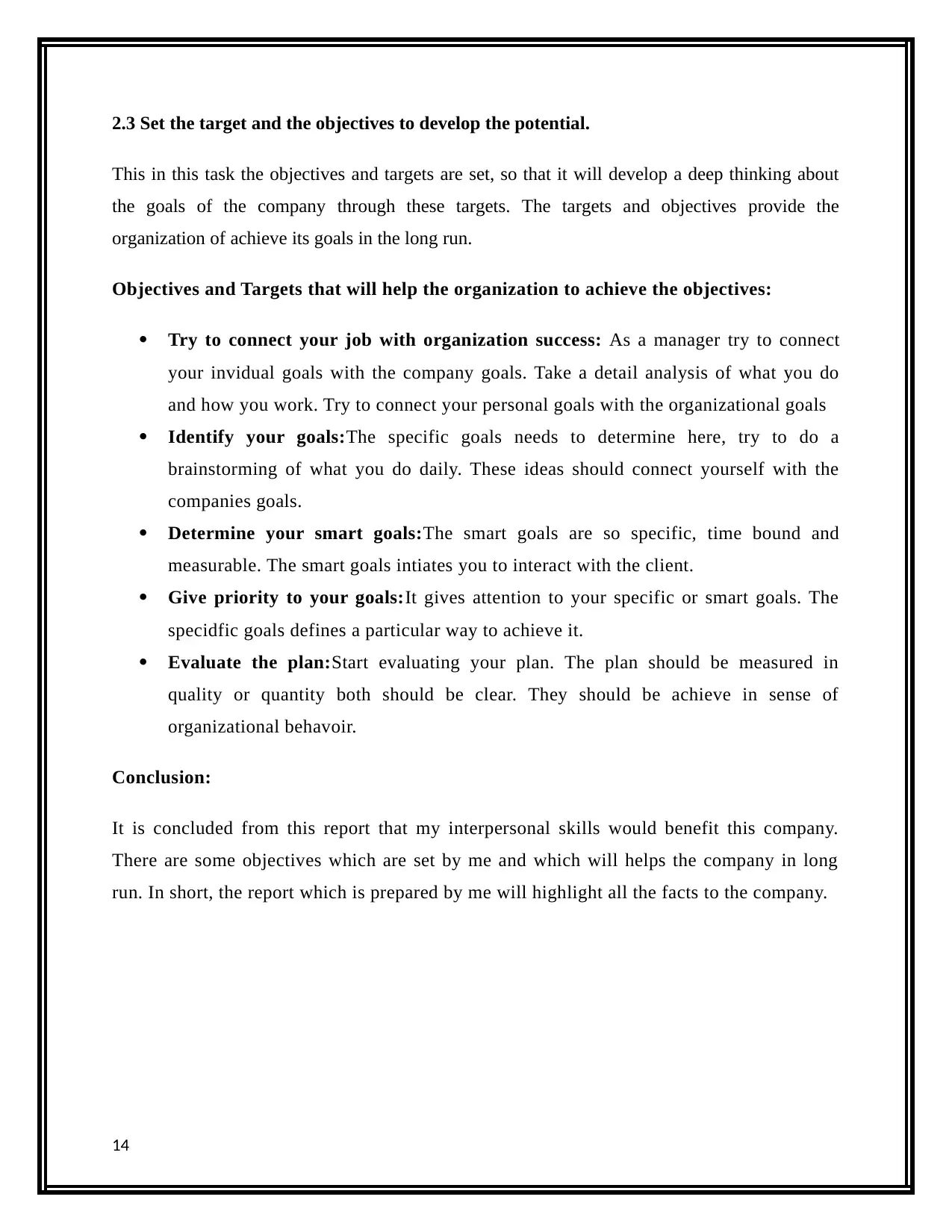
2.3 Set the target and the objectives to develop the potential.
This in this task the objectives and targets are set, so that it will develop a deep thinking about
the goals of the company through these targets. The targets and objectives provide the
organization of achieve its goals in the long run.
Objectives and Targets that will help the organization to achieve the objectives:
Try to connect your job with organization success: As a manager try to connect
your invidual goals with the company goals. Take a detail analysis of what you do
and how you work. Try to connect your personal goals with the organizational goals
Identify your goals:The specific goals needs to determine here, try to do a
brainstorming of what you do daily. These ideas should connect yourself with the
companies goals.
Determine your smart goals:The smart goals are so specific, time bound and
measurable. The smart goals intiates you to interact with the client.
Give priority to your goals:It gives attention to your specific or smart goals. The
specidfic goals defines a particular way to achieve it.
Evaluate the plan:Start evaluating your plan. The plan should be measured in
quality or quantity both should be clear. They should be achieve in sense of
organizational behavoir.
Conclusion:
It is concluded from this report that my interpersonal skills would benefit this company.
There are some objectives which are set by me and which will helps the company in long
run. In short, the report which is prepared by me will highlight all the facts to the company.
14
This in this task the objectives and targets are set, so that it will develop a deep thinking about
the goals of the company through these targets. The targets and objectives provide the
organization of achieve its goals in the long run.
Objectives and Targets that will help the organization to achieve the objectives:
Try to connect your job with organization success: As a manager try to connect
your invidual goals with the company goals. Take a detail analysis of what you do
and how you work. Try to connect your personal goals with the organizational goals
Identify your goals:The specific goals needs to determine here, try to do a
brainstorming of what you do daily. These ideas should connect yourself with the
companies goals.
Determine your smart goals:The smart goals are so specific, time bound and
measurable. The smart goals intiates you to interact with the client.
Give priority to your goals:It gives attention to your specific or smart goals. The
specidfic goals defines a particular way to achieve it.
Evaluate the plan:Start evaluating your plan. The plan should be measured in
quality or quantity both should be clear. They should be achieve in sense of
organizational behavoir.
Conclusion:
It is concluded from this report that my interpersonal skills would benefit this company.
There are some objectives which are set by me and which will helps the company in long
run. In short, the report which is prepared by me will highlight all the facts to the company.
14
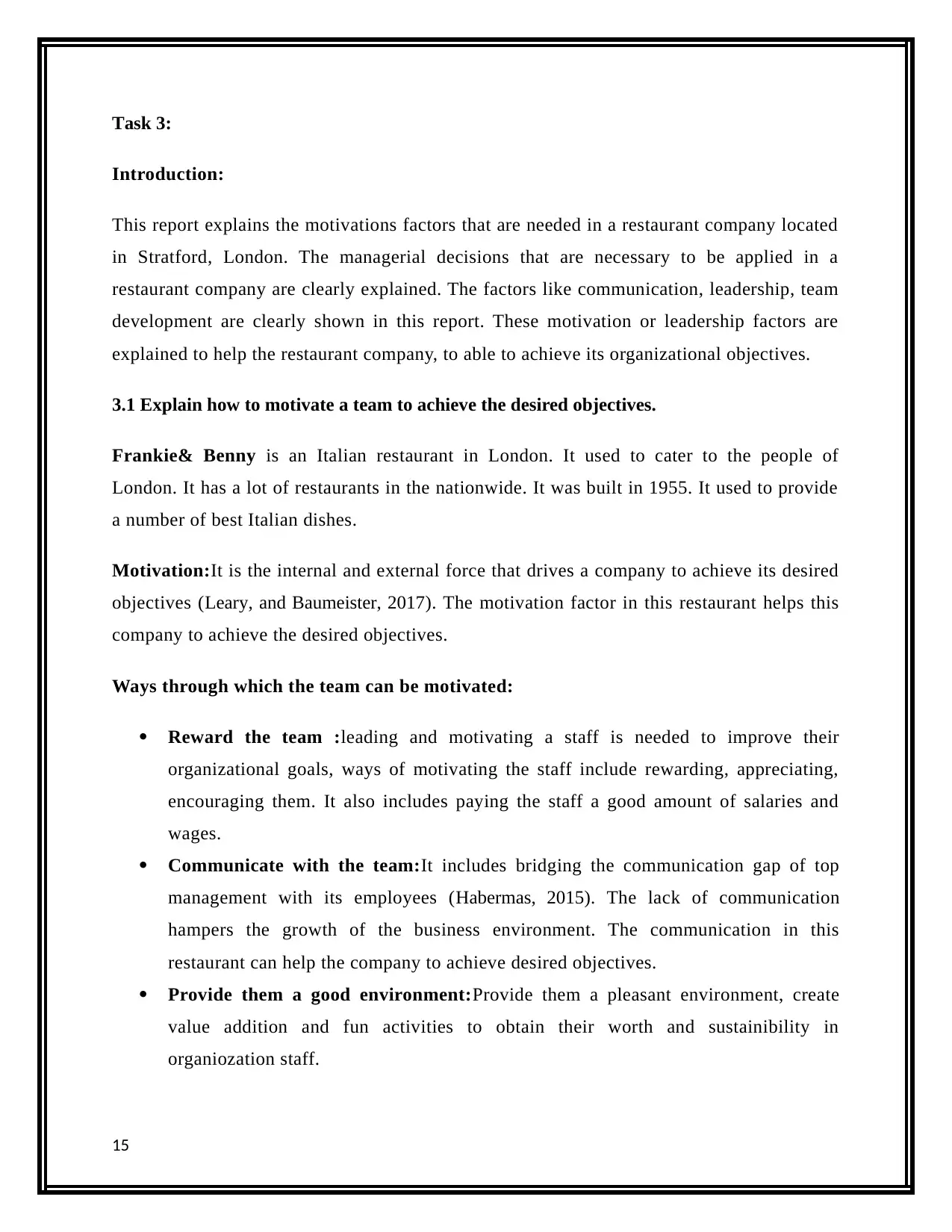
Task 3:
Introduction:
This report explains the motivations factors that are needed in a restaurant company located
in Stratford, London. The managerial decisions that are necessary to be applied in a
restaurant company are clearly explained. The factors like communication, leadership, team
development are clearly shown in this report. These motivation or leadership factors are
explained to help the restaurant company, to able to achieve its organizational objectives.
3.1 Explain how to motivate a team to achieve the desired objectives.
Frankie& Benny is an Italian restaurant in London. It used to cater to the people of
London. It has a lot of restaurants in the nationwide. It was built in 1955. It used to provide
a number of best Italian dishes.
Motivation:It is the internal and external force that drives a company to achieve its desired
objectives (Leary, and Baumeister, 2017). The motivation factor in this restaurant helps this
company to achieve the desired objectives.
Ways through which the team can be motivated:
Reward the team :leading and motivating a staff is needed to improve their
organizational goals, ways of motivating the staff include rewarding, appreciating,
encouraging them. It also includes paying the staff a good amount of salaries and
wages.
Communicate with the team:It includes bridging the communication gap of top
management with its employees (Habermas, 2015). The lack of communication
hampers the growth of the business environment. The communication in this
restaurant can help the company to achieve desired objectives.
Provide them a good environment:Provide them a pleasant environment, create
value addition and fun activities to obtain their worth and sustainibility in
organiozation staff.
15
Introduction:
This report explains the motivations factors that are needed in a restaurant company located
in Stratford, London. The managerial decisions that are necessary to be applied in a
restaurant company are clearly explained. The factors like communication, leadership, team
development are clearly shown in this report. These motivation or leadership factors are
explained to help the restaurant company, to able to achieve its organizational objectives.
3.1 Explain how to motivate a team to achieve the desired objectives.
Frankie& Benny is an Italian restaurant in London. It used to cater to the people of
London. It has a lot of restaurants in the nationwide. It was built in 1955. It used to provide
a number of best Italian dishes.
Motivation:It is the internal and external force that drives a company to achieve its desired
objectives (Leary, and Baumeister, 2017). The motivation factor in this restaurant helps this
company to achieve the desired objectives.
Ways through which the team can be motivated:
Reward the team :leading and motivating a staff is needed to improve their
organizational goals, ways of motivating the staff include rewarding, appreciating,
encouraging them. It also includes paying the staff a good amount of salaries and
wages.
Communicate with the team:It includes bridging the communication gap of top
management with its employees (Habermas, 2015). The lack of communication
hampers the growth of the business environment. The communication in this
restaurant can help the company to achieve desired objectives.
Provide them a good environment:Provide them a pleasant environment, create
value addition and fun activities to obtain their worth and sustainibility in
organiozation staff.
15
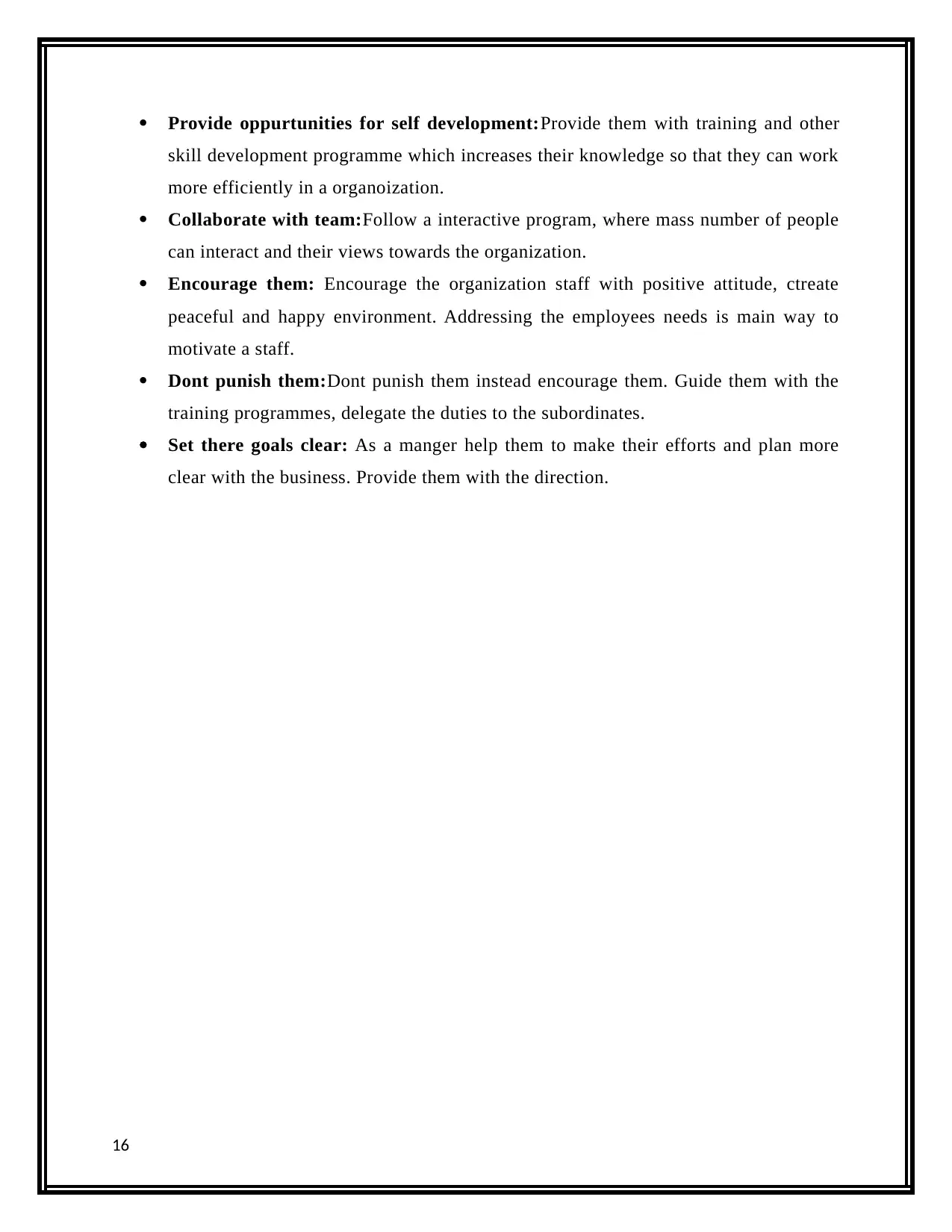
Provide oppurtunities for self development:Provide them with training and other
skill development programme which increases their knowledge so that they can work
more efficiently in a organoization.
Collaborate with team:Follow a interactive program, where mass number of people
can interact and their views towards the organization.
Encourage them: Encourage the organization staff with positive attitude, ctreate
peaceful and happy environment. Addressing the employees needs is main way to
motivate a staff.
Dont punish them:Dont punish them instead encourage them. Guide them with the
training programmes, delegate the duties to the subordinates.
Set there goals clear: As a manger help them to make their efforts and plan more
clear with the business. Provide them with the direction.
16
skill development programme which increases their knowledge so that they can work
more efficiently in a organoization.
Collaborate with team:Follow a interactive program, where mass number of people
can interact and their views towards the organization.
Encourage them: Encourage the organization staff with positive attitude, ctreate
peaceful and happy environment. Addressing the employees needs is main way to
motivate a staff.
Dont punish them:Dont punish them instead encourage them. Guide them with the
training programmes, delegate the duties to the subordinates.
Set there goals clear: As a manger help them to make their efforts and plan more
clear with the business. Provide them with the direction.
16
Secure Best Marks with AI Grader
Need help grading? Try our AI Grader for instant feedback on your assignments.
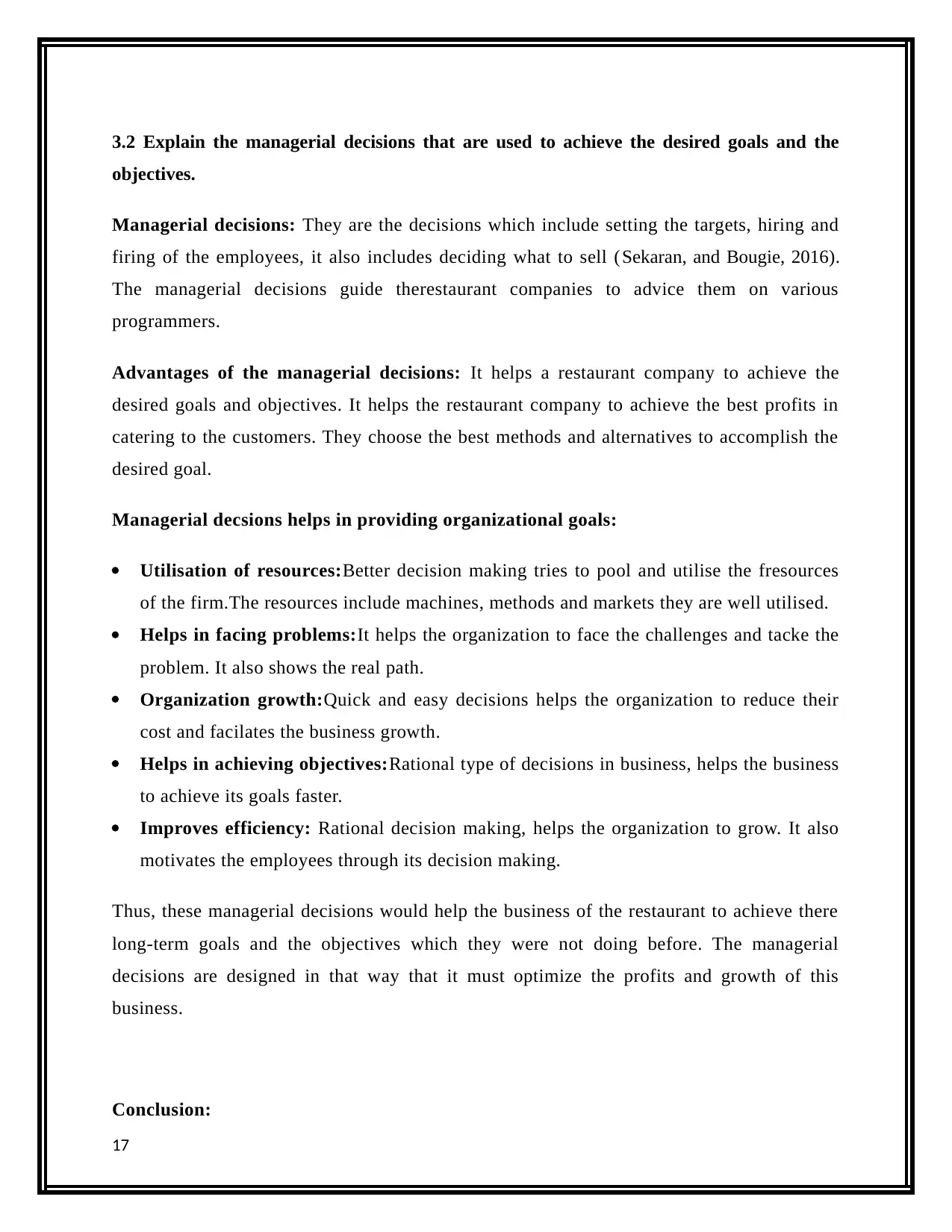
3.2 Explain the managerial decisions that are used to achieve the desired goals and the
objectives.
Managerial decisions: They are the decisions which include setting the targets, hiring and
firing of the employees, it also includes deciding what to sell (Sekaran, and Bougie, 2016).
The managerial decisions guide therestaurant companies to advice them on various
programmers.
Advantages of the managerial decisions: It helps a restaurant company to achieve the
desired goals and objectives. It helps the restaurant company to achieve the best profits in
catering to the customers. They choose the best methods and alternatives to accomplish the
desired goal.
Managerial decsions helps in providing organizational goals:
Utilisation of resources:Better decision making tries to pool and utilise the fresources
of the firm.The resources include machines, methods and markets they are well utilised.
Helps in facing problems:It helps the organization to face the challenges and tacke the
problem. It also shows the real path.
Organization growth:Quick and easy decisions helps the organization to reduce their
cost and facilates the business growth.
Helps in achieving objectives:Rational type of decisions in business, helps the business
to achieve its goals faster.
Improves efficiency: Rational decision making, helps the organization to grow. It also
motivates the employees through its decision making.
Thus, these managerial decisions would help the business of the restaurant to achieve there
long-term goals and the objectives which they were not doing before. The managerial
decisions are designed in that way that it must optimize the profits and growth of this
business.
Conclusion:
17
objectives.
Managerial decisions: They are the decisions which include setting the targets, hiring and
firing of the employees, it also includes deciding what to sell (Sekaran, and Bougie, 2016).
The managerial decisions guide therestaurant companies to advice them on various
programmers.
Advantages of the managerial decisions: It helps a restaurant company to achieve the
desired goals and objectives. It helps the restaurant company to achieve the best profits in
catering to the customers. They choose the best methods and alternatives to accomplish the
desired goal.
Managerial decsions helps in providing organizational goals:
Utilisation of resources:Better decision making tries to pool and utilise the fresources
of the firm.The resources include machines, methods and markets they are well utilised.
Helps in facing problems:It helps the organization to face the challenges and tacke the
problem. It also shows the real path.
Organization growth:Quick and easy decisions helps the organization to reduce their
cost and facilates the business growth.
Helps in achieving objectives:Rational type of decisions in business, helps the business
to achieve its goals faster.
Improves efficiency: Rational decision making, helps the organization to grow. It also
motivates the employees through its decision making.
Thus, these managerial decisions would help the business of the restaurant to achieve there
long-term goals and the objectives which they were not doing before. The managerial
decisions are designed in that way that it must optimize the profits and growth of this
business.
Conclusion:
17
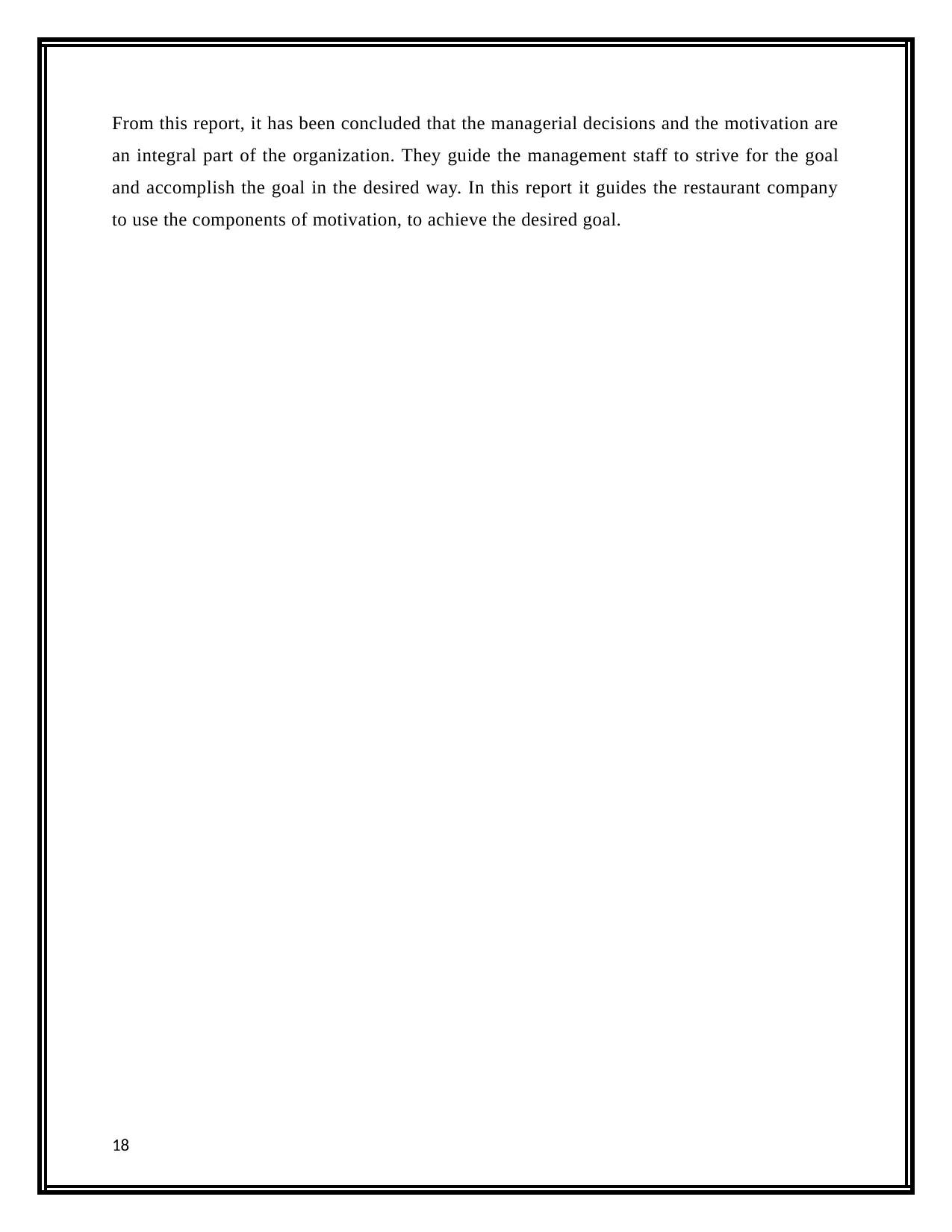
From this report, it has been concluded that the managerial decisions and the motivation are
an integral part of the organization. They guide the management staff to strive for the goal
and accomplish the goal in the desired way. In this report it guides the restaurant company
to use the components of motivation, to achieve the desired goal.
18
an integral part of the organization. They guide the management staff to strive for the goal
and accomplish the goal in the desired way. In this report it guides the restaurant company
to use the components of motivation, to achieve the desired goal.
18
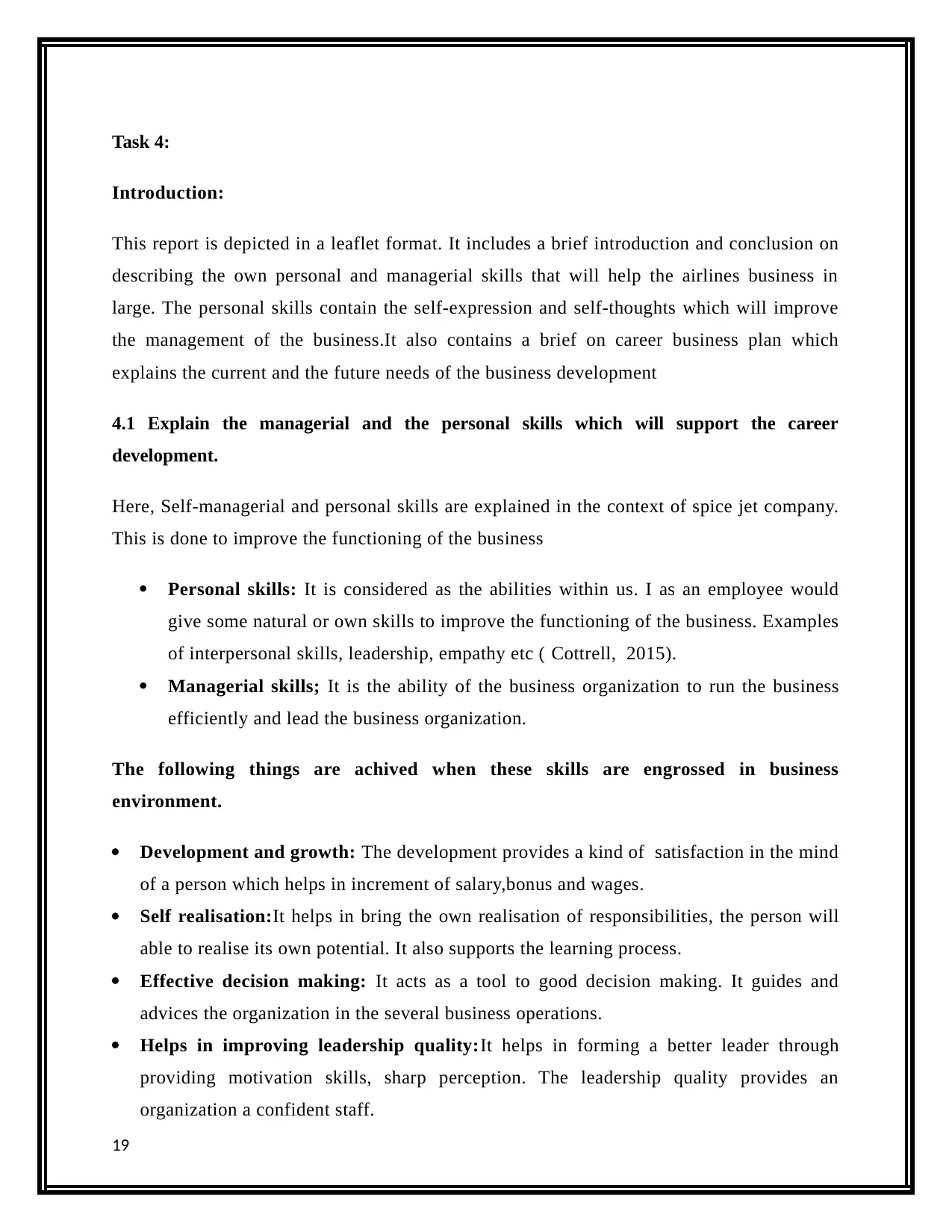
Task 4:
Introduction:
This report is depicted in a leaflet format. It includes a brief introduction and conclusion on
describing the own personal and managerial skills that will help the airlines business in
large. The personal skills contain the self-expression and self-thoughts which will improve
the management of the business.It also contains a brief on career business plan which
explains the current and the future needs of the business development
4.1 Explain the managerial and the personal skills which will support the career
development.
Here, Self-managerial and personal skills are explained in the context of spice jet company.
This is done to improve the functioning of the business
Personal skills: It is considered as the abilities within us. I as an employee would
give some natural or own skills to improve the functioning of the business. Examples
of interpersonal skills, leadership, empathy etc ( Cottrell, 2015).
Managerial skills; It is the ability of the business organization to run the business
efficiently and lead the business organization.
The following things are achived when these skills are engrossed in business
environment.
Development and growth: The development provides a kind of satisfaction in the mind
of a person which helps in increment of salary,bonus and wages.
Self realisation:It helps in bring the own realisation of responsibilities, the person will
able to realise its own potential. It also supports the learning process.
Effective decision making: It acts as a tool to good decision making. It guides and
advices the organization in the several business operations.
Helps in improving leadership quality:It helps in forming a better leader through
providing motivation skills, sharp perception. The leadership quality provides an
organization a confident staff.
19
Introduction:
This report is depicted in a leaflet format. It includes a brief introduction and conclusion on
describing the own personal and managerial skills that will help the airlines business in
large. The personal skills contain the self-expression and self-thoughts which will improve
the management of the business.It also contains a brief on career business plan which
explains the current and the future needs of the business development
4.1 Explain the managerial and the personal skills which will support the career
development.
Here, Self-managerial and personal skills are explained in the context of spice jet company.
This is done to improve the functioning of the business
Personal skills: It is considered as the abilities within us. I as an employee would
give some natural or own skills to improve the functioning of the business. Examples
of interpersonal skills, leadership, empathy etc ( Cottrell, 2015).
Managerial skills; It is the ability of the business organization to run the business
efficiently and lead the business organization.
The following things are achived when these skills are engrossed in business
environment.
Development and growth: The development provides a kind of satisfaction in the mind
of a person which helps in increment of salary,bonus and wages.
Self realisation:It helps in bring the own realisation of responsibilities, the person will
able to realise its own potential. It also supports the learning process.
Effective decision making: It acts as a tool to good decision making. It guides and
advices the organization in the several business operations.
Helps in improving leadership quality:It helps in forming a better leader through
providing motivation skills, sharp perception. The leadership quality provides an
organization a confident staff.
19
Paraphrase This Document
Need a fresh take? Get an instant paraphrase of this document with our AI Paraphraser
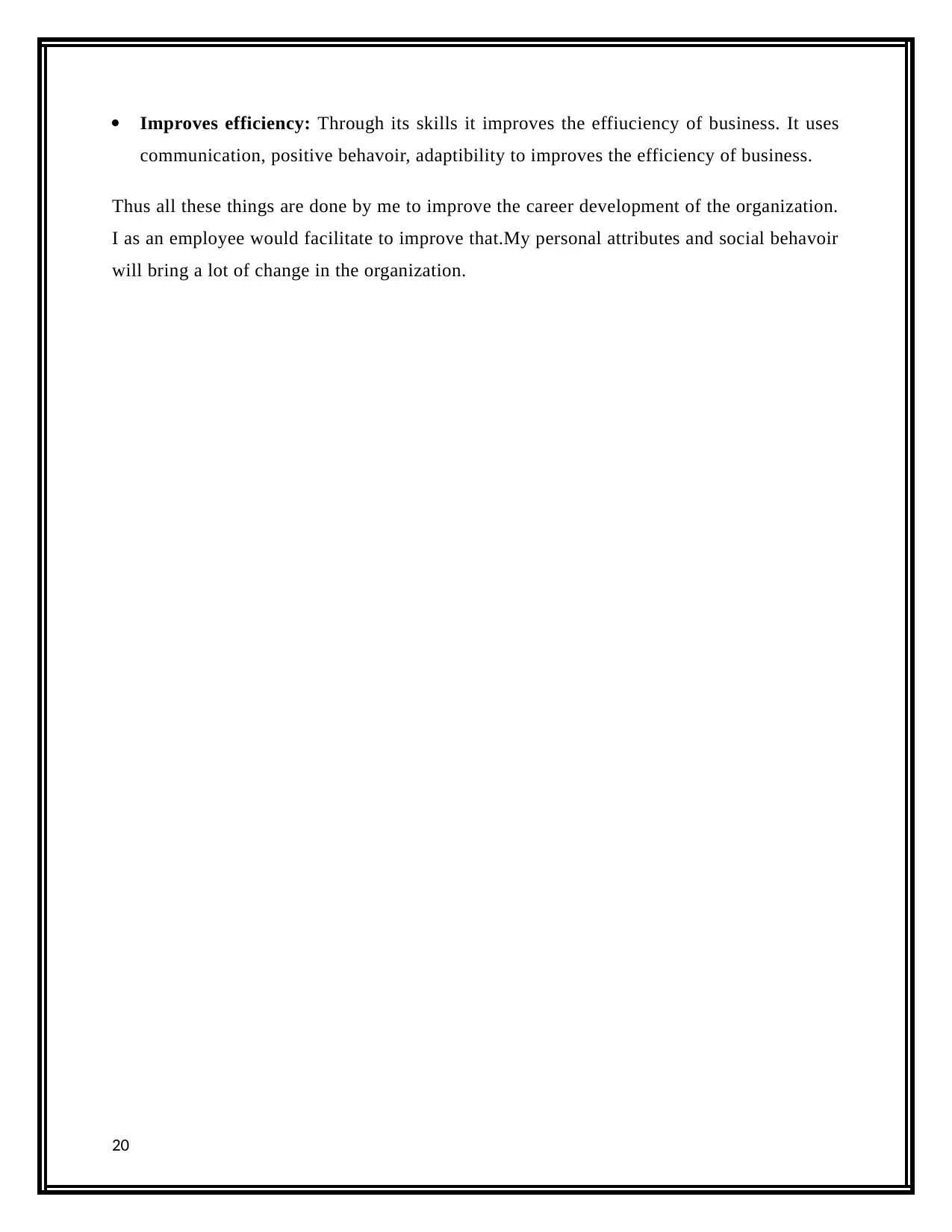
Improves efficiency: Through its skills it improves the effiuciency of business. It uses
communication, positive behavoir, adaptibility to improves the efficiency of business.
Thus all these things are done by me to improve the career development of the organization.
I as an employee would facilitate to improve that.My personal attributes and social behavoir
will bring a lot of change in the organization.
20
communication, positive behavoir, adaptibility to improves the efficiency of business.
Thus all these things are done by me to improve the career development of the organization.
I as an employee would facilitate to improve that.My personal attributes and social behavoir
will bring a lot of change in the organization.
20
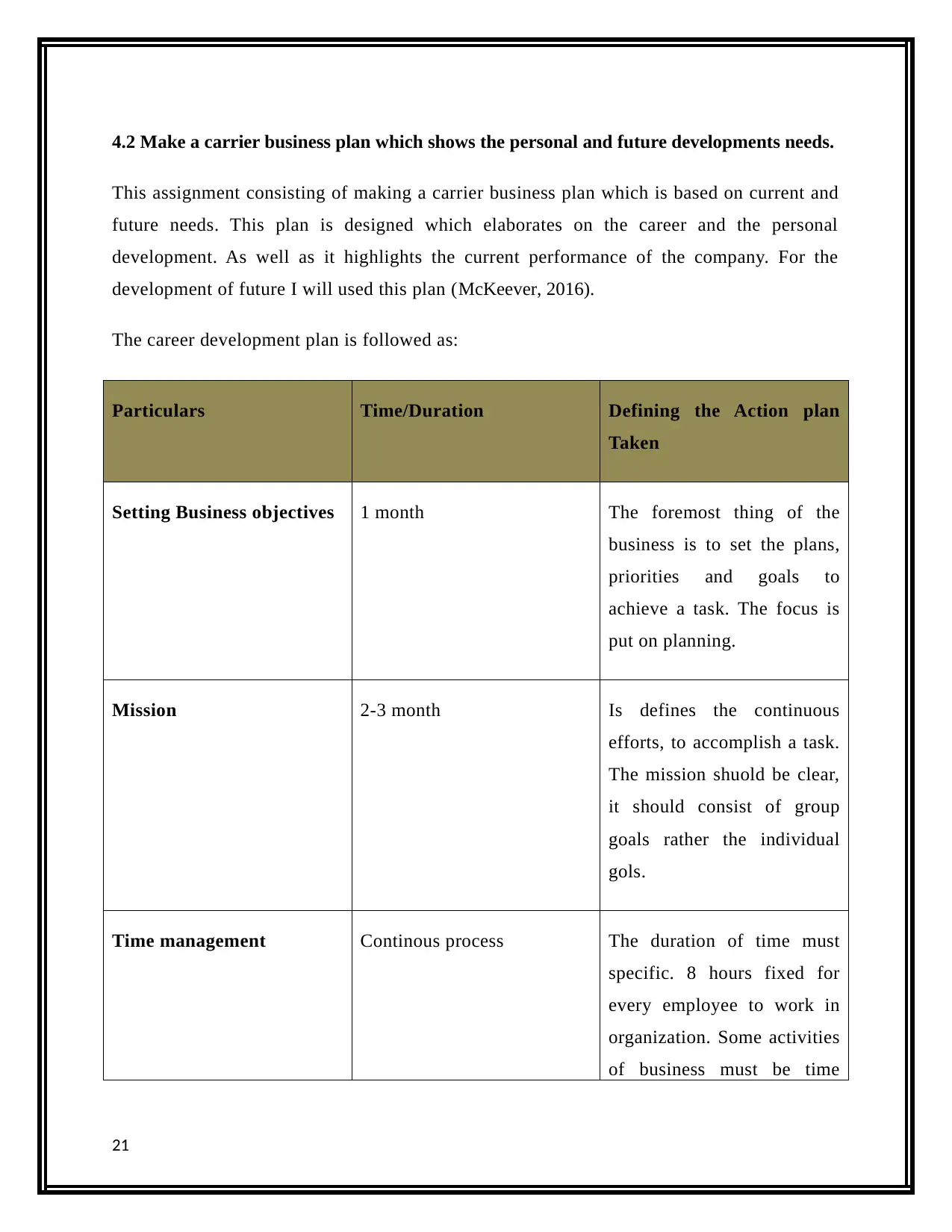
4.2 Make a carrier business plan which shows the personal and future developments needs.
This assignment consisting of making a carrier business plan which is based on current and
future needs. This plan is designed which elaborates on the career and the personal
development. As well as it highlights the current performance of the company. For the
development of future I will used this plan (McKeever, 2016).
The career development plan is followed as:
Particulars Time/Duration Defining the Action plan
Taken
Setting Business objectives 1 month The foremost thing of the
business is to set the plans,
priorities and goals to
achieve a task. The focus is
put on planning.
Mission 2-3 month Is defines the continuous
efforts, to accomplish a task.
The mission shuold be clear,
it should consist of group
goals rather the individual
gols.
Time management Continous process The duration of time must
specific. 8 hours fixed for
every employee to work in
organization. Some activities
of business must be time
21
This assignment consisting of making a carrier business plan which is based on current and
future needs. This plan is designed which elaborates on the career and the personal
development. As well as it highlights the current performance of the company. For the
development of future I will used this plan (McKeever, 2016).
The career development plan is followed as:
Particulars Time/Duration Defining the Action plan
Taken
Setting Business objectives 1 month The foremost thing of the
business is to set the plans,
priorities and goals to
achieve a task. The focus is
put on planning.
Mission 2-3 month Is defines the continuous
efforts, to accomplish a task.
The mission shuold be clear,
it should consist of group
goals rather the individual
gols.
Time management Continous process The duration of time must
specific. 8 hours fixed for
every employee to work in
organization. Some activities
of business must be time
21
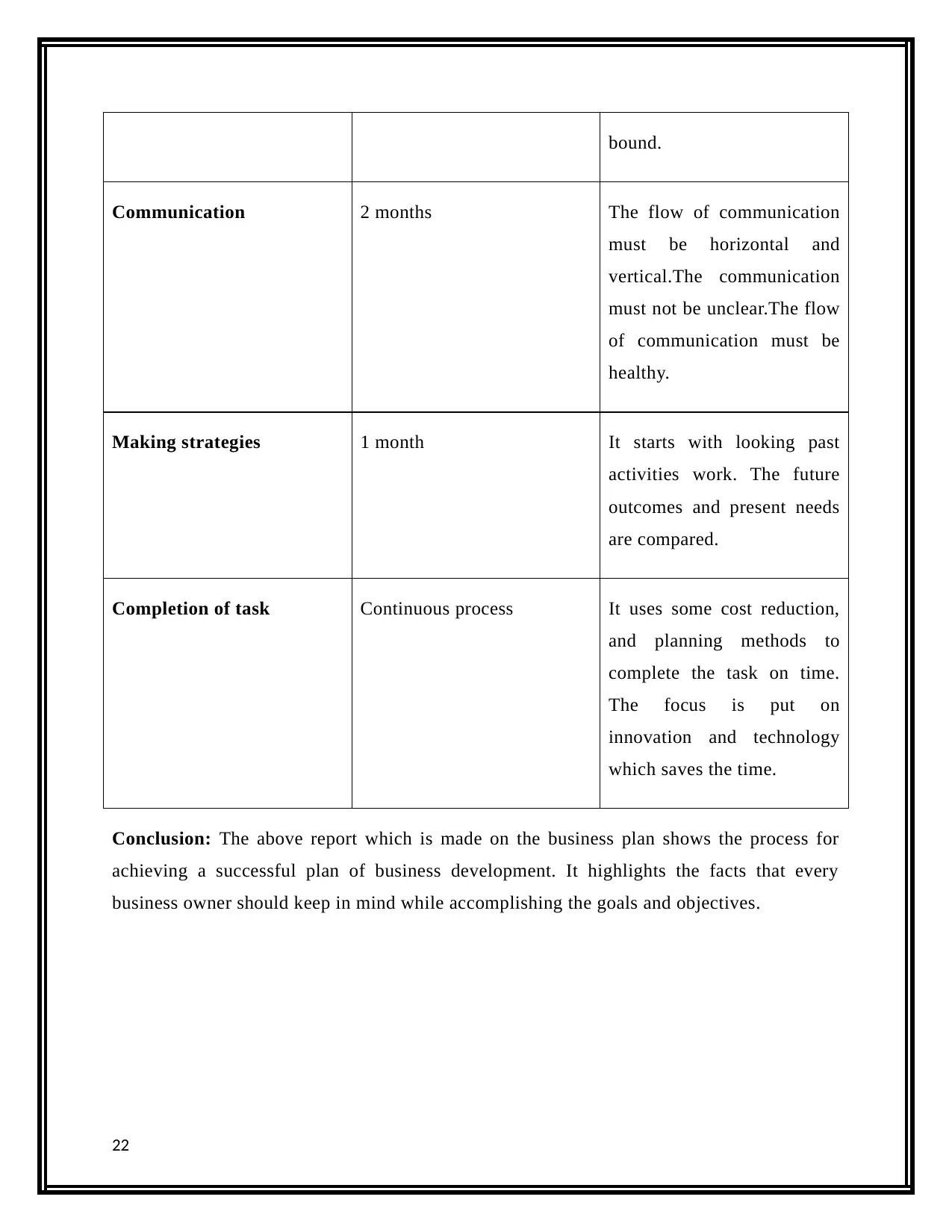
bound.
Communication 2 months The flow of communication
must be horizontal and
vertical.The communication
must not be unclear.The flow
of communication must be
healthy.
Making strategies 1 month It starts with looking past
activities work. The future
outcomes and present needs
are compared.
Completion of task Continuous process It uses some cost reduction,
and planning methods to
complete the task on time.
The focus is put on
innovation and technology
which saves the time.
Conclusion: The above report which is made on the business plan shows the process for
achieving a successful plan of business development. It highlights the facts that every
business owner should keep in mind while accomplishing the goals and objectives.
22
Communication 2 months The flow of communication
must be horizontal and
vertical.The communication
must not be unclear.The flow
of communication must be
healthy.
Making strategies 1 month It starts with looking past
activities work. The future
outcomes and present needs
are compared.
Completion of task Continuous process It uses some cost reduction,
and planning methods to
complete the task on time.
The focus is put on
innovation and technology
which saves the time.
Conclusion: The above report which is made on the business plan shows the process for
achieving a successful plan of business development. It highlights the facts that every
business owner should keep in mind while accomplishing the goals and objectives.
22
Secure Best Marks with AI Grader
Need help grading? Try our AI Grader for instant feedback on your assignments.
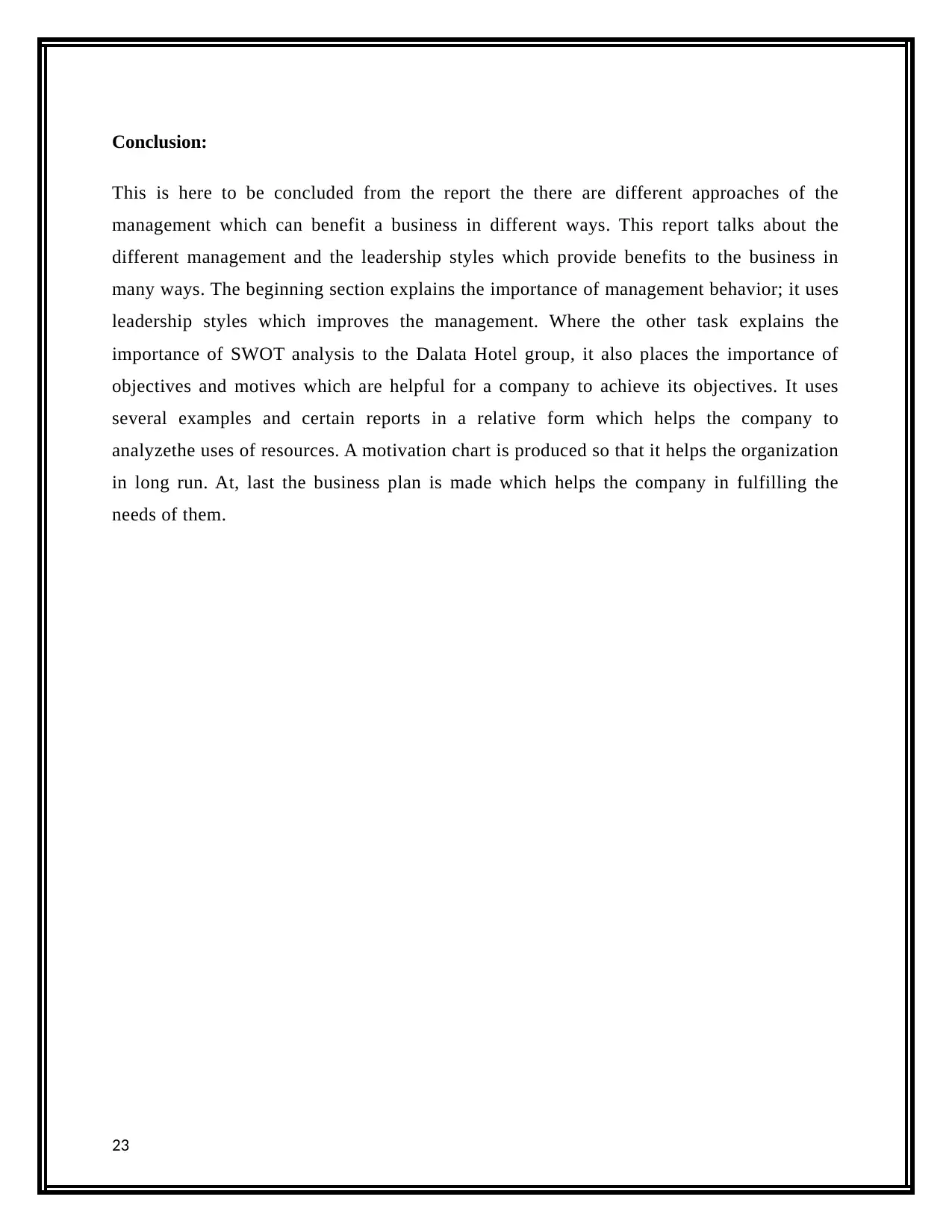
Conclusion:
This is here to be concluded from the report the there are different approaches of the
management which can benefit a business in different ways. This report talks about the
different management and the leadership styles which provide benefits to the business in
many ways. The beginning section explains the importance of management behavior; it uses
leadership styles which improves the management. Where the other task explains the
importance of SWOT analysis to the Dalata Hotel group, it also places the importance of
objectives and motives which are helpful for a company to achieve its objectives. It uses
several examples and certain reports in a relative form which helps the company to
analyzethe uses of resources. A motivation chart is produced so that it helps the organization
in long run. At, last the business plan is made which helps the company in fulfilling the
needs of them.
23
This is here to be concluded from the report the there are different approaches of the
management which can benefit a business in different ways. This report talks about the
different management and the leadership styles which provide benefits to the business in
many ways. The beginning section explains the importance of management behavior; it uses
leadership styles which improves the management. Where the other task explains the
importance of SWOT analysis to the Dalata Hotel group, it also places the importance of
objectives and motives which are helpful for a company to achieve its objectives. It uses
several examples and certain reports in a relative form which helps the company to
analyzethe uses of resources. A motivation chart is produced so that it helps the organization
in long run. At, last the business plan is made which helps the company in fulfilling the
needs of them.
23
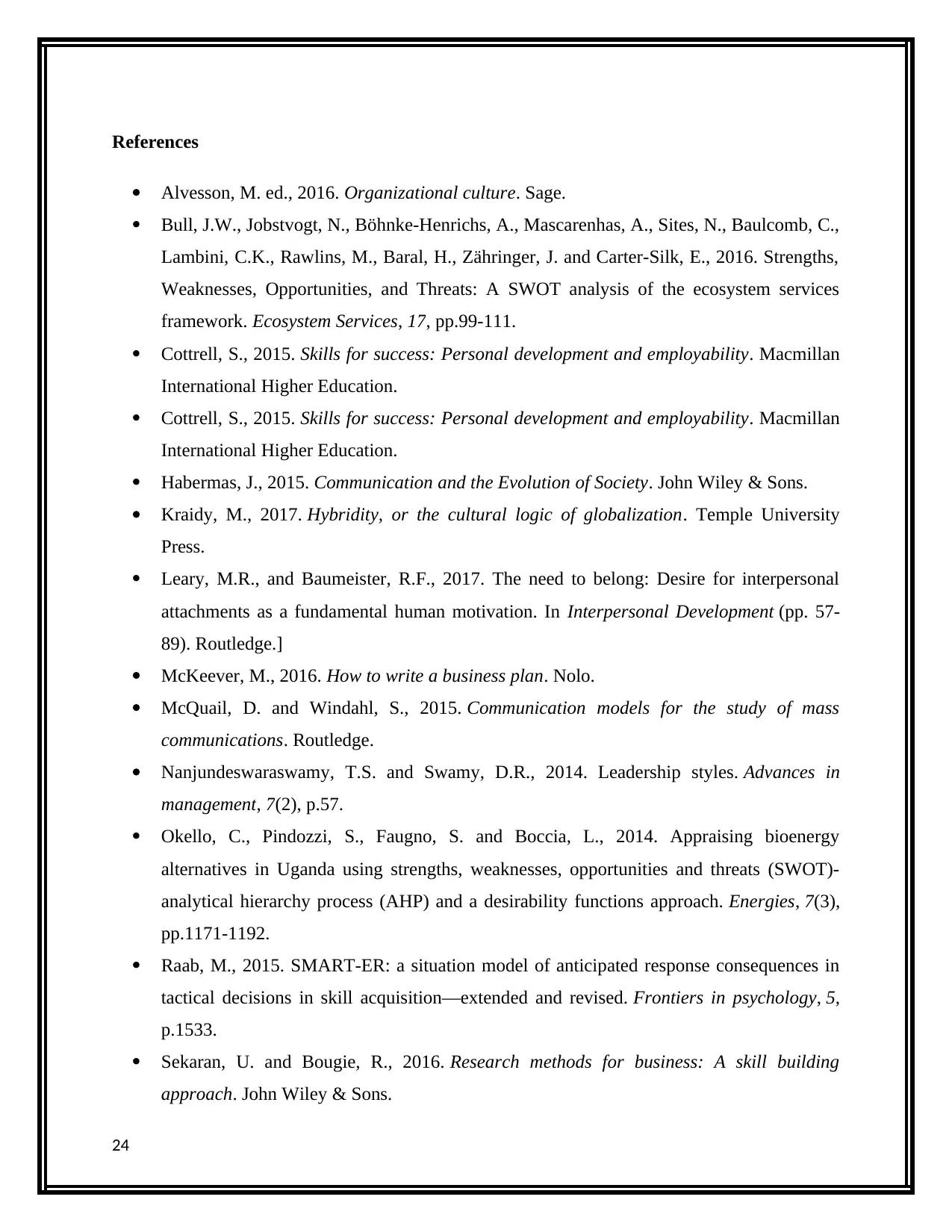
References
Alvesson, M. ed., 2016. Organizational culture. Sage.
Bull, J.W., Jobstvogt, N., Böhnke-Henrichs, A., Mascarenhas, A., Sites, N., Baulcomb, C.,
Lambini, C.K., Rawlins, M., Baral, H., Zähringer, J. and Carter-Silk, E., 2016. Strengths,
Weaknesses, Opportunities, and Threats: A SWOT analysis of the ecosystem services
framework. Ecosystem Services, 17, pp.99-111.
Cottrell, S., 2015. Skills for success: Personal development and employability. Macmillan
International Higher Education.
Cottrell, S., 2015. Skills for success: Personal development and employability. Macmillan
International Higher Education.
Habermas, J., 2015. Communication and the Evolution of Society. John Wiley & Sons.
Kraidy, M., 2017. Hybridity, or the cultural logic of globalization. Temple University
Press.
Leary, M.R., and Baumeister, R.F., 2017. The need to belong: Desire for interpersonal
attachments as a fundamental human motivation. In Interpersonal Development (pp. 57-
89). Routledge.]
McKeever, M., 2016. How to write a business plan. Nolo.
McQuail, D. and Windahl, S., 2015. Communication models for the study of mass
communications. Routledge.
Nanjundeswaraswamy, T.S. and Swamy, D.R., 2014. Leadership styles. Advances in
management, 7(2), p.57.
Okello, C., Pindozzi, S., Faugno, S. and Boccia, L., 2014. Appraising bioenergy
alternatives in Uganda using strengths, weaknesses, opportunities and threats (SWOT)-
analytical hierarchy process (AHP) and a desirability functions approach. Energies, 7(3),
pp.1171-1192.
Raab, M., 2015. SMART-ER: a situation model of anticipated response consequences in
tactical decisions in skill acquisition—extended and revised. Frontiers in psychology, 5,
p.1533.
Sekaran, U. and Bougie, R., 2016. Research methods for business: A skill building
approach. John Wiley & Sons.
24
Alvesson, M. ed., 2016. Organizational culture. Sage.
Bull, J.W., Jobstvogt, N., Böhnke-Henrichs, A., Mascarenhas, A., Sites, N., Baulcomb, C.,
Lambini, C.K., Rawlins, M., Baral, H., Zähringer, J. and Carter-Silk, E., 2016. Strengths,
Weaknesses, Opportunities, and Threats: A SWOT analysis of the ecosystem services
framework. Ecosystem Services, 17, pp.99-111.
Cottrell, S., 2015. Skills for success: Personal development and employability. Macmillan
International Higher Education.
Cottrell, S., 2015. Skills for success: Personal development and employability. Macmillan
International Higher Education.
Habermas, J., 2015. Communication and the Evolution of Society. John Wiley & Sons.
Kraidy, M., 2017. Hybridity, or the cultural logic of globalization. Temple University
Press.
Leary, M.R., and Baumeister, R.F., 2017. The need to belong: Desire for interpersonal
attachments as a fundamental human motivation. In Interpersonal Development (pp. 57-
89). Routledge.]
McKeever, M., 2016. How to write a business plan. Nolo.
McQuail, D. and Windahl, S., 2015. Communication models for the study of mass
communications. Routledge.
Nanjundeswaraswamy, T.S. and Swamy, D.R., 2014. Leadership styles. Advances in
management, 7(2), p.57.
Okello, C., Pindozzi, S., Faugno, S. and Boccia, L., 2014. Appraising bioenergy
alternatives in Uganda using strengths, weaknesses, opportunities and threats (SWOT)-
analytical hierarchy process (AHP) and a desirability functions approach. Energies, 7(3),
pp.1171-1192.
Raab, M., 2015. SMART-ER: a situation model of anticipated response consequences in
tactical decisions in skill acquisition—extended and revised. Frontiers in psychology, 5,
p.1533.
Sekaran, U. and Bougie, R., 2016. Research methods for business: A skill building
approach. John Wiley & Sons.
24

Shockley-Zalabak, P., 2014. Fundamentals of organizational communication. Boston,
MA: Pearson.
Sosik, J.J. and Jung, D., 2018. Full range leadership development: Pathways for people,
profit, and planet. Routledge.
Young, C. and Ghoshal, S., 2016. Organization theory and the multinational corporation.
Springer.
25
MA: Pearson.
Sosik, J.J. and Jung, D., 2018. Full range leadership development: Pathways for people,
profit, and planet. Routledge.
Young, C. and Ghoshal, S., 2016. Organization theory and the multinational corporation.
Springer.
25
1 out of 25
Related Documents
Your All-in-One AI-Powered Toolkit for Academic Success.
+13062052269
info@desklib.com
Available 24*7 on WhatsApp / Email
![[object Object]](/_next/static/media/star-bottom.7253800d.svg)
Unlock your academic potential
© 2024 | Zucol Services PVT LTD | All rights reserved.





